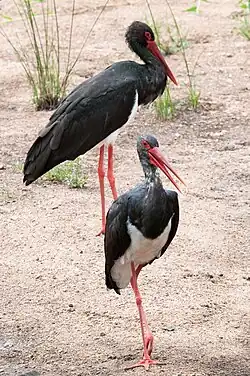Portal:India
Portal maintenance status: (June 2018)
|

Introduction
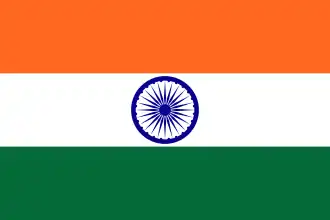
India, officially the Republic of India, is a country in South Asia. It is the seventh-largest country by area; the most populous country since 2023; and, since its independence in 1947, the world's most populous democracy. Bounded by the Indian Ocean on the south, the Arabian Sea on the southwest, and the Bay of Bengal on the southeast, it shares land borders with Pakistan to the west; China, Nepal, and Bhutan to the north; and Bangladesh and Myanmar to the east. In the Indian Ocean, India is near Sri Lanka and the Maldives; its Andaman and Nicobar Islands share a maritime border with Myanmar, Thailand, and Indonesia. (Full article...)
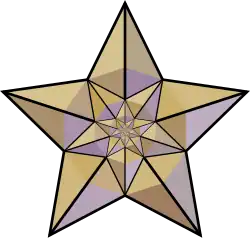 Featured article –
Featured article –
-
 Image 1
Image 1
The black stork (Ciconia nigra) is a large bird in the stork family Ciconiidae. It was first described by Carl Linnaeus in the 10th edition of his Systema Naturae. Measuring on average 95 to 100 cm (37 to 39 in) from beak tip to end of tail with a 145-to-155 cm (57-to-61 in) wingspan, the adult black stork has mainly black plumage, with white underparts, long red legs and a long pointed red beak. A widespread but uncommon species, it breeds in scattered locations across Europe (predominantly in Portugal and Spain, and central and eastern parts), and east across the Palearctic to the Pacific Ocean. It is a long-distance migrant, with European populations wintering in tropical Sub-Saharan Africa, and Asian populations in the Indian subcontinent. When migrating between Europe and Africa, it avoids crossing broad expanses of the Mediterranean Sea and detours via the Levant in the east, the Strait of Sicily in the center, or the Strait of Gibraltar in the west. An isolated non-migratory population lives in Southern Africa.
Unlike the closely related white stork, the black stork is a shy and wary species. It is seen singly or in pairs, usually in marshy areas, rivers or inland waters. It feeds on amphibians, small fish and insects, generally wading slowly in shallow water stalking its prey. Breeding pairs usually build nests in large forest trees—most commonly deciduous but also coniferous—which can be seen from long distances, as well as on large boulders, or under overhanging ledges in mountainous areas. The female lays two to five greyish-white eggs, which become soiled over time in the nest. Incubation takes 32 to 38 days, with both sexes sharing duties, and fledging takes 60 to 71 days. (Full article...) -
 Image 2
Image 2.png) Kapadia in 2018
Kapadia in 2018
Dimple Kapadia (born 8 June 1957) is an Indian actress predominantly appearing in Hindi films. Born and raised in Mumbai by wealthy parents, she aspired to become an actress from a young age and received her first opportunity through her father's efforts to launch her in the film industry. She was discovered at age 14 by the filmmaker Raj Kapoor, who cast her in the title role of his teen romance Bobby (1973), which opened to major commercial success and gained her wide public recognition. Shortly before the film's release in 1973, she married the actor Rajesh Khanna and quit acting. Their daughters, Twinkle and Rinke Khanna, both briefly worked as actresses in their youth. Kapadia returned to films in 1984, two years after her separation from Khanna. Her comeback film Saagar, which was released a year later, revived her career. Both Bobby and Saagar won her Filmfare Awards for Best Actress. Through her work over the next decade, she established herself as one of Hindi cinema's leading actresses.
While her initial roles often relied on her perceived beauty and sex appeal, Kapadia was keen to challenge herself and expand her range. She was among the first actresses who starred in women-centred Hindi action films but found greater favour with critics when she took on more dramatic roles in both mainstream and neorealist parallel cinema. Appearing in films ranging from marital dramas to literary adaptations, she played troubled women sometimes deemed reflective of her personal experience, and received acclaim for her performances in Kaash (1987), Drishti (1990), Lekin... (1991), and Rudaali (1993). For her role as a professional mourner in Rudaali, she won the National Film Award for Best Actress and a Filmfare Critics Award. She also had supporting roles in the crime dramas Prahaar (1991), Angaar (1992), Gardish (1993) and Krantiveer (1994), the latter securing her another Filmfare Award. (Full article...) -
 Image 3Mother India is a 1957 Indian epic drama film, directed by Mehboob Khan and starring Nargis, Sunil Dutt, Rajendra Kumar and Raaj Kumar. A remake of Khan's earlier film Aurat (1940), it is the story of a poverty-stricken village woman named Radha (Nargis), who in the absence of her husband, struggles to raise her sons and survive against a cunning money-lender amidst many troubles.
Image 3Mother India is a 1957 Indian epic drama film, directed by Mehboob Khan and starring Nargis, Sunil Dutt, Rajendra Kumar and Raaj Kumar. A remake of Khan's earlier film Aurat (1940), it is the story of a poverty-stricken village woman named Radha (Nargis), who in the absence of her husband, struggles to raise her sons and survive against a cunning money-lender amidst many troubles.
The title of the film was chosen to counter American author Katherine Mayo's 1927 polemical book Mother India, which vilified Indian culture. Mother India metaphorically represents India as a nation in the aftermath of its independence in 1947, and alludes to a strong sense of Indian nationalism and nation-building. Allusions to Hindu mythology are abundant in the film, and its lead character has been seen as a metonymic representation of an Indian woman who reflects high moral values and the concept of what it means to be a mother to society through self-sacrifice. While some authors treat Radha as the symbol of women's empowerment, others see her cast in female stereotypes. The film was shot in Mumbai's Mehboob Studios and in the villages of Maharashtra, Gujarat, and Uttar Pradesh. The music by Naushad introduced global music, including Western classical music and orchestra, to Hindi cinema. (Full article...) -
 Image 4Sir Robert Eric Mortimer Wheeler CH CIE MC TD FRS FBA FSA (10 September 1890 – 22 July 1976) was a British archaeologist and officer in the British Army. Over the course of his career, he served as Director of both the National Museum of Wales and London Museum, Director-General of the Archaeological Survey of India, and the founder and Honorary Director of the Institute of Archaeology in London, in addition to writing twenty-four books on archaeological subjects.
Image 4Sir Robert Eric Mortimer Wheeler CH CIE MC TD FRS FBA FSA (10 September 1890 – 22 July 1976) was a British archaeologist and officer in the British Army. Over the course of his career, he served as Director of both the National Museum of Wales and London Museum, Director-General of the Archaeological Survey of India, and the founder and Honorary Director of the Institute of Archaeology in London, in addition to writing twenty-four books on archaeological subjects.
Born in Glasgow to a middle-class family, Wheeler was raised largely in Yorkshire before moving to London in his teenage years. After studying classics at University College London (UCL), he began working professionally in archaeology, specialising in the Romano-British period. During World War I he volunteered for service in the Royal Artillery, being stationed on the Western Front, where he rose to the rank of major and was awarded the Military Cross. Returning to Britain, he obtained his doctorate from UCL before taking on a position at the National Museum of Wales, first as Keeper of Archaeology and then as Director, during which time he oversaw excavation at the Roman forts of Segontium, Y Gaer, and Isca Augusta with the aid of his first wife, Tessa Wheeler. Influenced by the archaeologist Augustus Pitt Rivers, Wheeler argued that excavation and the recording of stratigraphic context required an increasingly scientific and methodical approach, developing the "Wheeler method". In 1926, he was appointed Keeper of the London Museum; there, he oversaw a reorganisation of the collection, successfully lobbied for increased funding, and began lecturing at UCL. (Full article...) -
 Image 5Dilwale Dulhania Le Jayenge (transl. The Brave-Hearted Will Take the Bride), also known by the initialism DDLJ, is a 1995 Indian Hindi-language musical romance film written and directed by Aditya Chopra in his directorial debut and produced by his father Yash Chopra. The film stars Shah Rukh Khan and Kajol as Raj and Simran, two young non-resident Indians, who fall in love during a vacation through Europe with their friends. Raj tries to win over Simran's family so the couple can marry, but Simran's father has long since promised her hand to his friend's son. The film was shot in India, London, and Switzerland, from September 1994 to August 1995.
Image 5Dilwale Dulhania Le Jayenge (transl. The Brave-Hearted Will Take the Bride), also known by the initialism DDLJ, is a 1995 Indian Hindi-language musical romance film written and directed by Aditya Chopra in his directorial debut and produced by his father Yash Chopra. The film stars Shah Rukh Khan and Kajol as Raj and Simran, two young non-resident Indians, who fall in love during a vacation through Europe with their friends. Raj tries to win over Simran's family so the couple can marry, but Simran's father has long since promised her hand to his friend's son. The film was shot in India, London, and Switzerland, from September 1994 to August 1995.
With an estimated total gross of ₹102.5 crore (today's adjusted gross ₹524 crore), with ₹89 crore (today's adjusted gross ₹455 crore) earned in India and ₹13.50 crore (today's adjusted gross ₹69 crore) in overseas, the film was the highest-grossing Indian film of 1995 and one of the most successful Indian films in history. When adjusted for inflation, it is the second highest-grossing Indian film of the 1990s, behind Hum Aapke Hain Koun..! It won 10 Filmfare Awards—the most for a single film at that time—and the National Film Award for Best Popular Film Providing Wholesome Entertainment. Its soundtrack album became one of the most popular of the 1990s. (Full article...) -
 Image 6
Image 6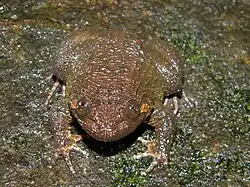
Nyctibatrachus major, the Malabar night frog, large wrinkled frog, or Boulenger's narrow-eyed frog, is a species of frog in the family Nyctibatrachidae, commonly known as the robust frogs. It was described in 1882 by the zoologist George Albert Boulenger, and is the type species of the genus Nyctibatrachus. It is a large frog for its genus, with an adult snout–vent length of 31.5–52.0 mm (1.24–2.05 in) for males and 43.7–54.2 mm (1.72–2.13 in) for females. It is mainly brownish to greyish in colour, with a dark greyish-brown upperside, a greyish-white underside, and light grey sides. It also has a variety of grey or brown markings. When preserved in ethanol, it is mostly greyish-brown to grey, with whitish sides. Sexes can be told apart by the presence of the femoral glands (bulbous glands near the inner thigh) in males.
The species is endemic to the Western Ghats mountain range of India, where it is found in Kerala, Tamil Nadu, and Karnataka. Adults inhabit fast-moving forest streams at elevations of up to 900 m (3,000 ft) and have highly specific habitat requirements. Adults are mostly found in or near water and are nocturnal; subadults can be found during both the night and day. Its diet mainly consists of other frogs and insect larvae. Over a period of several days or weeks, females lay multiple small clutches of eggs on leaves and rocks overhanging water; tadpoles drop into the water below on hatching. The species is currently classified as being vulnerable on the IUCN Red List owing to its small and fragmented range and ongoing habitat degradation. Threats to the species include habitat loss, increased human presence near the streams it inhabits, and possibly nitrate pollution caused by fertiliser overuse. (Full article...) -
![Image 7 Padukone at the 2018 Cannes Film Festival Deepika Prakash Padukone (pronounced [d̪iːpɪkaː pəɖʊkoːɳeː]; born 5 January 1986) is an Indian actress who works predominantly in Hindi films. Her accolades include three Filmfare Awards. Time named her one of the 100 most influential people in the world in 2018 and awarded her the Time100 Impact Award in 2022. Padukone, the daughter of the badminton player Prakash Padukone, was born in Copenhagen and raised in Bangalore. As a teenager, she played badminton in national level championships but left her career in the sport to become a fashion model. She soon received offers for film roles and made her acting debut in 2006 as the title character of the Kannada film Aishwarya. Padukone then played a dual role opposite Shah Rukh Khan in her first Bollywood release, the romance Om Shanti Om (2007), which won her the Filmfare Award for Best Female Debut. Padukone received praise for her starring role in the romance Love Aaj Kal (2009), but this was followed by a brief setback. (Full article...)](./_assets_/Blank.png) Image 7
Image 7.jpg) Padukone at the 2018 Cannes Film Festival
Padukone at the 2018 Cannes Film Festival
Deepika Prakash Padukone (pronounced [d̪iːpɪkaː pəɖʊkoːɳeː]; born 5 January 1986) is an Indian actress who works predominantly in Hindi films. Her accolades include three Filmfare Awards. Time named her one of the 100 most influential people in the world in 2018 and awarded her the Time100 Impact Award in 2022.
Padukone, the daughter of the badminton player Prakash Padukone, was born in Copenhagen and raised in Bangalore. As a teenager, she played badminton in national level championships but left her career in the sport to become a fashion model. She soon received offers for film roles and made her acting debut in 2006 as the title character of the Kannada film Aishwarya. Padukone then played a dual role opposite Shah Rukh Khan in her first Bollywood release, the romance Om Shanti Om (2007), which won her the Filmfare Award for Best Female Debut. Padukone received praise for her starring role in the romance Love Aaj Kal (2009), but this was followed by a brief setback. (Full article...) -
 Image 8Loev (pronounced love) is a 2015 Indian romantic drama film written and directed by Sudhanshu Saria. It stars Dhruv Ganesh and Shiv Panditt as two friends who set off to the Western Ghats for a weekend trip and focuses on their complex emotional and sexual relationship. It was Ganesh's final film, as he died from tuberculosis before its release. Loev also features Siddharth Menon and Rishabh Chaddha in supporting roles. The film's title is a deliberate misspelling of the word "love".
Image 8Loev (pronounced love) is a 2015 Indian romantic drama film written and directed by Sudhanshu Saria. It stars Dhruv Ganesh and Shiv Panditt as two friends who set off to the Western Ghats for a weekend trip and focuses on their complex emotional and sexual relationship. It was Ganesh's final film, as he died from tuberculosis before its release. Loev also features Siddharth Menon and Rishabh Chaddha in supporting roles. The film's title is a deliberate misspelling of the word "love".
Saria wrote Loev's script while he was working on the draft of the unreleased film I Am Here and drew heavily from his personal experiences. It was eventually picked up for production by Arfi Lamba and Katherine Suckale despite Saria's own doubts on its viability. Principal photography took place at Mahabaleshwar, in the Western Ghats in peninsular India, and at Mumbai. The film was shot in the summer of 2014 over the course of sixteen days by the cinematographer Sherri Kauk in 2K resolution. It relied on crowdfunding and cost-cutting measures; its budget was relatively low at US$1 million. (Full article...) -
 Image 9
Image 9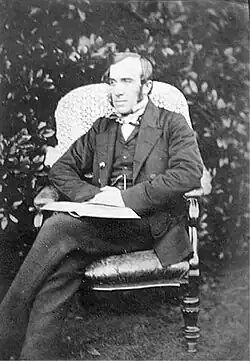
Monier Williams, elected as the second Boden Professor of Sanskrit in 1860; this photograph was taken by Lewis Carroll.
The election in 1860 for the position of Boden Professor of Sanskrit at the University of Oxford was a competition between two candidates offering different approaches to Sanskrit scholarship. One was Monier Williams, an Oxford-educated Englishman who had spent 14 years teaching Sanskrit to those preparing to work in British India for the East India Company. The other, Max Müller, was a German-born lecturer at Oxford specialising in comparative philology, the science of language. He had spent many years working on an edition of the Rig Veda (an ancient collection of Vedic Sanskrit hymns) and had gained an international reputation for his scholarship. Williams, in contrast, worked on later material and had little time for the "continental" school of Sanskrit scholarship that Müller exemplified. Williams regarded the study of Sanskrit as a means to an end, namely the conversion of India to Christianity. In Müller's opinion, his own work, while it would assist missionaries, was also valuable as an end in itself.
The election came at a time of public debate about British rule in India in the wake of the Indian Rebellion of 1857. Opinions were divided on whether greater efforts should be made to convert India or whether to remain sensitive to local culture and traditions. Both men battled for the votes of the electorate (the Convocation of the university, consisting of over 3,700 graduates) through manifestos and newspaper correspondence. Williams laid great stress in his campaign on the intention of the original founder of the chair, that the holder should assist in converting India through dissemination of the Christian scriptures. Müller's view was that his work on the Rig Veda was of great value for missionary work, and published testimonials accordingly. He also wanted to teach wider subjects such as Indian history and literature to assist missionaries, scholars, and civil servants – a proposal that Williams criticised as not in accordance with the original benefactor's wishes. The rival campaigns took out newspaper advertisements and circulated manifestos, and different newspapers backed each man. Although generally regarded as superior to Williams in scholarship, Müller had the double disadvantage (in the eyes of some) of being German and having liberal Christian views. Some of the newspaper pronouncements in favour of Williams were based on a claimed national interest of having an Englishman as Boden professor to assist with the work of governing and converting India. (Full article...) -
 Image 10
Image 10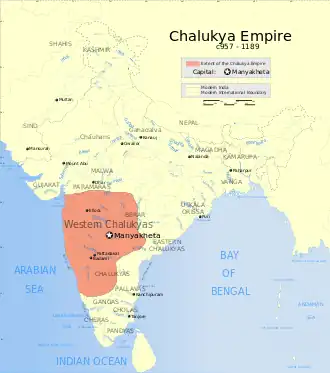
Territory of the Western Chalukyas (c. 1100 CE) in India (modern boundaries shown) and the empire's capital, Kalyani, in the modern Bidar district, Karnataka state, India
A large body of Western Chalukya literature in the Kannada language was produced during the reign of the Western Chalukya Empire (973–1200 CE) in what is now southern India. This dynasty, which ruled most of the western Deccan in South India, is sometimes called the Kalyani Chalukya dynasty after its royal capital at Kalyani (now Basavakalyan), and sometimes called the Later Chalukya dynasty for its theoretical relationship to the 6th-century Chalukya dynasty of Badami. For a brief period (1162–1183), the Kalachuris of Kalyani, a dynasty of kings who had earlier migrated to the Karnataka region from central India and served as vassals for several generations, exploited the growing weakness of their overlords and annexed the Kalyani. Around 1183, the last Chalukya scion, Someshvara IV, overthrew the Kalachuris to regain control of the royal city. But his efforts were in vain, as other prominent Chalukya vassals in the Deccan, the Hoysalas, the Kakatiyas and the Seunas destroyed the remnants of the Chalukya power.
Kannada literature from this period is usually categorised into the linguistic phase called Old-Kannada. It constituted the bulk of the Chalukya court's textual production and pertained mostly to writings relating to the socio-religious development of the Jain faith. The earliest well-known writers belonging to the Shaiva faith are also from this period. Under the patronage of Kalachuri King Bijjala II, whose prime minister was the well-known Kannada poet and social reformer Basavanna, a native form of poetic literature called Vachana literature (lit "utterance", "saying" or "sentence") proliferated. The beginnings of the Vachana poetic tradition in the Kannada-speaking region trace back to the early 11th century. Kannada literature written in the champu metre, composed of prose and verse, was popularised by the Chalukyan court poets. However, with the advent of the Veerashaiva (lit, "brave devotees of the god Shiva") religious movement in the mid-12th century, poets favoured the native tripadi (three-line verse composed of eleven ganas or prosodic units), hadugabba (song-poem) and free verse metres for their poems. (Full article...) -
 Image 11
Image 11.jpg) Shah in 2022
Shah in 2022
Shefali Shah (née Shetty; born 22 May 1973) is an Indian actress of film, television and theatre. Working primarily in independent Hindi films, she has received multiple local and foreign accolades for her performances. Shah's acting career started on the Gujarati stage before she debuted on television in 1993. After small parts on television and a brief stint with cinema in Rangeela (1995), she gained wider recognition in 1997 for her role in the popular series Hasratein. This was followed by lead roles in the TV series Kabhie Kabhie (1997) and Raahein (1999). A supporting role in the crime film Satya (1998) won her positive notice and a Filmfare Critics Award, and she soon shifted her focus to film acting starting with a lead role in the Gujarati drama Dariya Chhoru (1999).
Shah was selective about her roles through the following decades, resulting in intermittent film work, mostly in character parts and often to appreciation from critics. She appeared in the international co-production Monsoon Wedding (2001) and the mainstream comedy-drama Waqt: The Race Against Time (2005). In 2007, her portrayal of Kasturba Gandhi in the biographical drama Gandhi, My Father won her the Best Actress prize at the Tokyo International Film Festival, and she received the National Film Award for Best Supporting Actress for the drama film The Last Lear. Among her subsequent film roles, she played a leading part in Kucch Luv Jaisaa (2011) and was noted for her work in the social problem film Lakshmi (2014) and the ensemble drama Dil Dhadakne Do (2015). (Full article...) -
 Image 12
Image 12.jpg) Chopra in 2024
Chopra in 2024
Priyanka Chopra (born 18 July 1982) is an Indian actress and producer. The winner of the Miss World 2000 pageant, she is India's highest-paid actress and has been honored with many accolades, including two National Film Awards and five Filmfare Awards. In 2016, the Government of India honoured her with the Padma Shri, and Time named her one of the 100 most influential people in the world. Forbes listed her among the World's 100 Most Powerful Women, and in 2022, she was named in the BBC 100 Women list.
Chopra accepted offers to join the Indian film industry following her pageant wins. Her acting debut came in the Tamil film Thamizhan (2002), followed by her first Bollywood feature in The Hero: Love Story of a Spy (2003). She played the leading lady in the box-office hits Andaaz (2003) and Mujhse Shaadi Karogi (2004) and had her breakout role in the 2004 romantic thriller Aitraaz. Chopra established herself with starring roles in the top-grossing productions Krrish and Don (both 2006), and later reprised her role in their sequels. For playing a troubled model in the drama Fashion (2008), Chopra won a National Film Award and a Filmfare Award for Best Actress. Chopra gained further praise for portraying a range of characters in the films Kaminey (2009), 7 Khoon Maaf (2011), Barfi! (2012), Mary Kom (2014), Dil Dhadakne Do (2015), and Bajirao Mastani (2015). (Full article...) -
![Image 13 Mukerji in 2024 Rani Mukerji (Hindustani pronunciation: [raːni mʊkʰərdʒi]; born 21 March 1978) is an Indian actress who works in Hindi films. Noted for her versatility in a range of genres from romantic comedies to crime dramas, she is the recipient of multiple accolades. Born into the Mukherjee-Samarth family, Mukerji dabbled with acting as a teenager by starring in her father Ram Mukherjee's Bengali-language film Biyer Phool and in the social drama Raja Ki Aayegi Baaraat (both 1996). Mukerji had her first commercial success with the action film Ghulam and breakthrough with the romance Kuch Kuch Hota Hai (both 1998). Following a brief setback, the year 2002 marked a turning point for her when she was cast by Yash Raj Films as the star of the drama Saathiya. (Full article...)](./_assets_/Blank.png) Image 13
Image 13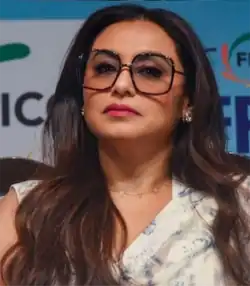 Mukerji in 2024
Mukerji in 2024
Rani Mukerji (Hindustani pronunciation: [raːni mʊkʰərdʒi]; born 21 March 1978) is an Indian actress who works in Hindi films. Noted for her versatility in a range of genres from romantic comedies to crime dramas, she is the recipient of multiple accolades.
Born into the Mukherjee-Samarth family, Mukerji dabbled with acting as a teenager by starring in her father Ram Mukherjee's Bengali-language film Biyer Phool and in the social drama Raja Ki Aayegi Baaraat (both 1996). Mukerji had her first commercial success with the action film Ghulam and breakthrough with the romance Kuch Kuch Hota Hai (both 1998). Following a brief setback, the year 2002 marked a turning point for her when she was cast by Yash Raj Films as the star of the drama Saathiya. (Full article...) -
 Image 14Taare Zameen Par (lit. 'Stars on the Earth'), also known as Like Stars on Earth in English, is a 2007 Indian Hindi-language psychological drama film produced and directed by Aamir Khan. It stars Khan, with Darsheel Safary, Tanay Chheda, Vipin Sharma and Tisca Chopra. It explores the life and imagination of Ishaan (Safary), an artistically gifted 8-year-old boy whose poor academic performance leads his parents to send him to a boarding school, where a new art teacher Nikumbh (Khan) suspects that he is dyslexic and helps him to overcome his reading disorder. The film focuses on raising awareness about dyslexia in children.
Image 14Taare Zameen Par (lit. 'Stars on the Earth'), also known as Like Stars on Earth in English, is a 2007 Indian Hindi-language psychological drama film produced and directed by Aamir Khan. It stars Khan, with Darsheel Safary, Tanay Chheda, Vipin Sharma and Tisca Chopra. It explores the life and imagination of Ishaan (Safary), an artistically gifted 8-year-old boy whose poor academic performance leads his parents to send him to a boarding school, where a new art teacher Nikumbh (Khan) suspects that he is dyslexic and helps him to overcome his reading disorder. The film focuses on raising awareness about dyslexia in children.
Creative director and writer Amole Gupte developed the idea with his wife Deepa Bhatia, who was the film's editor. Shankar–Ehsaan–Loy composed the score, and Prasoon Joshi wrote the lyrics for many of the songs. Principal photography took place in Mumbai, and in Panchgani's New Era High School, where some of the school's students participated in the filming. (Full article...) -
 Image 15
Image 15 Bhatt at the 2022 Berlinale
Bhatt at the 2022 Berlinale
Alia Bhatt (/ˈɑːliə ˈbʌt/; born 15 March 1993) is a British actress of Indian descent who predominantly works in Hindi films. Known for her portrayals of women in challenging circumstances, she has received several accolades, including a National Film Award and six Filmfare Awards. She is one of India's highest-paid actresses. Time awarded her with the Time100 Impact Award in 2022 and named her one of the 100 most influential people in the world in 2024.
Born into the Bhatt family, she is a daughter of filmmaker Mahesh Bhatt and actress Soni Razdan. After making her acting debut as a child in the 1999 thriller film Sangharsh, she played her first leading role in Karan Johar's teen film Student of the Year (2012). She won the Filmfare Critics Award for Best Actress for playing a kidnapping victim in the road drama Highway (2014) and went on to establish herself with starring roles in several romantic films produced by Johar's studio Dharma Productions. (Full article...) -
 Image 16
Image 16
Core area of Western Chalukya architectural activity in modern Karnataka state, India
Western Chalukya architecture, also known as Kalyani Chalukya or Later Chalukya architecture and broadly classified under the Vesara Style, is the distinctive style of ornamented architecture that evolved during the rule of the Western Chalukya Empire in the Tungabhadra region of modern central Karnataka, India, during the 11th and 12th centuries. Western Chalukyan political influence was at its peak in the Deccan Plateau during this period. The centre of cultural and temple-building activity lay in the Tungabhadra region, where large medieval workshops built numerous monuments. These monuments, regional variants of pre-existing dravida (South Indian) temples, form a climax to the wider regional temple architecture tradition called Vesara or Karnata dravida. Temples of all sizes built by the Chalukyan architects during this era remain today as examples of the architectural style.
Most notable of the many buildings dating from this period are the Mahadeva Temple at Itagi in the Koppal district, the Kasivisvesvara Temple at Lakkundi in the Gadag district, the Mallikarjuna Temple at Kuruvatti in the Bellary district and the Kallesvara Temple at Bagali in the Davangere district. Other monuments notable for their craftsmanship include the Kaitabheshvara Temple in Kubatur and Kedareshvara Temple in Balligavi, both in the Shimoga district, the Siddhesvara Temple at Haveri in the Haveri district, the Amrtesvara Temple at Annigeri in the Dharwad district, the Sarasvati Temple in Gadag, and the Dodda Basappa Temple at Dambal, both in the Gadag district. (Full article...) -
 Image 17
Image 17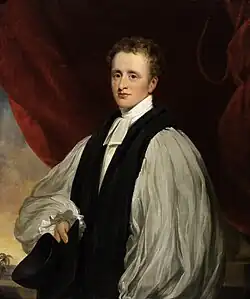
Reginald Heber (21 April 1783 – 3 April 1826) was an English Anglican bishop, a man of letters, and hymn-writer. After 16 years as a country parson, he served as Bishop of Calcutta until his death at the age of 42. The son of a rich landowner and cleric, Heber gained fame at the University of Oxford as a poet. After graduation he made an extended tour of Scandinavia, Russia and Central Europe. Ordained in 1807, he took over his father's old parish, Hodnet, Shropshire. He also wrote hymns and general literature, including a study of the works of the 17th-century cleric Jeremy Taylor.
He was consecrated Bishop of Calcutta in October 1823. He travelled widely and worked to improve the spiritual and general living conditions of his flock. Arduous duties, a hostile climate and poor health led to his collapse and death after less than three years in India. Memorials were erected there and in St Paul's Cathedral, London. A collection of his hymns appeared soon after his death. "Holy, Holy, Holy! Lord God Almighty" remains popular for Trinity Sunday, while "Brightest and Best" is frequently sung during Epiphany. (Full article...) -
 Image 18Nil Battey Sannata (lit. 'Zero Divided by Zero Equals Nothing'; slang for "Good for Nothing"), released internationally as The New Classmate, is a 2015 Indian Hindi-language comedy drama film directed by Ashwiny Iyer Tiwari in her feature debut. Produced by Aanand L. Rai, Ajay Rai, and Alan McAlex under the banners of Colour Yellow Productions and JAR Pictures, the film was co-written by Iyer, Neeraj Singh, Pranjal Choudhary, and Nitesh Tiwari. Swara Bhaskar starred as Chanda Sahay, a high-school drop-out household maid and single mother of a sullen young girl named Apeksha, played by Riya Shukla. The film's theme is a person's right to dream and change their lives, irrespective of social status.
Image 18Nil Battey Sannata (lit. 'Zero Divided by Zero Equals Nothing'; slang for "Good for Nothing"), released internationally as The New Classmate, is a 2015 Indian Hindi-language comedy drama film directed by Ashwiny Iyer Tiwari in her feature debut. Produced by Aanand L. Rai, Ajay Rai, and Alan McAlex under the banners of Colour Yellow Productions and JAR Pictures, the film was co-written by Iyer, Neeraj Singh, Pranjal Choudhary, and Nitesh Tiwari. Swara Bhaskar starred as Chanda Sahay, a high-school drop-out household maid and single mother of a sullen young girl named Apeksha, played by Riya Shukla. The film's theme is a person's right to dream and change their lives, irrespective of social status.
Released in India on 22 April 2016, Nil Battey Sannata was distributed by Eros International and garnered critical and audience acclaim. Reviewers praised most aspects of the production, especially its narrative and realism, and the performances of the cast, Bhaskar's in particular. At the 62nd Filmfare Awards, Iyer won the Filmfare Award for Best Debut Director, while Bhaskar and Shukla won the Screen Awards for Best Actress (Critics) and Best Child Artist respectively. The film did well at the box-office, collecting a total of around ₹69 million (US$820,000) during its entire theatrical run. The same year, the film was remade in Tamil as Amma Kanakku, with Iyer returning to direct. The following year, it was remade in Malayalam as Udaharanam Sujatha. (Full article...) -
 Image 19Osbert Guy Stanhope Crawford CBE FBA FSA (28 October 1886 – 28 November 1957) was a British archaeologist who specialised in the archaeology of prehistoric Britain and Sudan. A keen proponent of aerial archaeology, he spent most of his career as the archaeological officer of the Ordnance Survey (OS) and also wrote a range of books on archaeological subjects.
Image 19Osbert Guy Stanhope Crawford CBE FBA FSA (28 October 1886 – 28 November 1957) was a British archaeologist who specialised in the archaeology of prehistoric Britain and Sudan. A keen proponent of aerial archaeology, he spent most of his career as the archaeological officer of the Ordnance Survey (OS) and also wrote a range of books on archaeological subjects.
Born in Bombay, British India, to a wealthy middle-class Scottish family, Crawford moved to England as an infant and was raised by his aunts in London and Hampshire. He studied geography at Keble College, Oxford, and worked briefly in that field before devoting himself professionally to archaeology. Employed by the philanthropist Henry Wellcome, Crawford oversaw the excavation of Abu Geili in Sudan before returning to England shortly before the First World War. During the conflict he served in both the London Scottish Regiment and the Royal Flying Corps, where he was involved in ground and aerial reconnaissance along the Western Front. After an injury forced a period of convalescence in England, he returned to the Western Front, where he was captured by the German Army in 1918 and held as a prisoner of war until the end of the conflict. (Full article...) -
![Image 20 Lage Raho Munna Bhai (pronounced [ləˈɡeː rəˈɦoː mʊnːaːˈbʱaːi] ⓘ; translation: Keep Going, Munna Bhai) is a 2006 Indian Hindi-language satirical comedy drama film written, edited and directed by Rajkumar Hirani, who also co-wrote the screenplay with Abhijat Joshi, and produced by Vidhu Vinod Chopra under the banner Vinod Chopra Films. A sequel to Munna Bhai M.B.B.S. (2003), the film is the second installment of the Munna Bhai series. Sanjay Dutt and Arshad Warsi reprised their roles as the titular Munna Bhai and Circuit, respectively. New additions to the cast include Vidya Balan, Dilip Prabhavalkar and Dia Mirza, while several actors from the original, notably Jimmy Sheirgill and Boman Irani, appear in new roles. In this film, the eponymous lead character, a don in the Mumbai underworld, begins to see visions of Mahatma Gandhi. Through his interactions with Gandhi, he begins to practice what he refers to as "Gandhigiri" (a neologism for "Gandhism") to help ordinary people solve their problems. (Full article...)](./_assets_/Blank.png) Image 20Lage Raho Munna Bhai (pronounced [ləˈɡeː rəˈɦoː mʊnːaːˈbʱaːi] ⓘ; translation: Keep Going, Munna Bhai) is a 2006 Indian Hindi-language satirical comedy drama film written, edited and directed by Rajkumar Hirani, who also co-wrote the screenplay with Abhijat Joshi, and produced by Vidhu Vinod Chopra under the banner Vinod Chopra Films. A sequel to Munna Bhai M.B.B.S. (2003), the film is the second installment of the Munna Bhai series. Sanjay Dutt and Arshad Warsi reprised their roles as the titular Munna Bhai and Circuit, respectively. New additions to the cast include Vidya Balan, Dilip Prabhavalkar and Dia Mirza, while several actors from the original, notably Jimmy Sheirgill and Boman Irani, appear in new roles.
Image 20Lage Raho Munna Bhai (pronounced [ləˈɡeː rəˈɦoː mʊnːaːˈbʱaːi] ⓘ; translation: Keep Going, Munna Bhai) is a 2006 Indian Hindi-language satirical comedy drama film written, edited and directed by Rajkumar Hirani, who also co-wrote the screenplay with Abhijat Joshi, and produced by Vidhu Vinod Chopra under the banner Vinod Chopra Films. A sequel to Munna Bhai M.B.B.S. (2003), the film is the second installment of the Munna Bhai series. Sanjay Dutt and Arshad Warsi reprised their roles as the titular Munna Bhai and Circuit, respectively. New additions to the cast include Vidya Balan, Dilip Prabhavalkar and Dia Mirza, while several actors from the original, notably Jimmy Sheirgill and Boman Irani, appear in new roles.
In this film, the eponymous lead character, a don in the Mumbai underworld, begins to see visions of Mahatma Gandhi. Through his interactions with Gandhi, he begins to practice what he refers to as "Gandhigiri" (a neologism for "Gandhism") to help ordinary people solve their problems. (Full article...) -
 Image 21
Image 21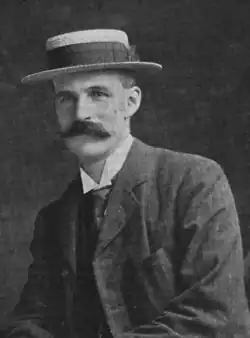 Poore pictured in 1899
Poore pictured in 1899
Brigadier-General Robert Montagu Poore, CIE, DSO, DL, JP (20 March 1866 – 14 July 1938) was an Anglo-Irish cricketer and British Army officer who, while serving in South Africa in 1896, played in three Test matches for the South African cricket team. He featured most prominently in first-class cricket playing county cricket in England for Hampshire between 1898 and 1906, where he gained a reputation as a batsman, having notable success in 1899 when he was the highest first-class run-scorer in England. Alongside playing for Hampshire, Poore also played first-class cricket in India for the Europeans in the Bombay Presidency Matches. An all-round sportsman, he was also a capable swordsman, and polo, tennis, racquets, and squash player, in addition to being a skilled marksman. Poore had success in the Royal Naval and Military Tournaments, being adjudged the best man-at-arms on four occasions.
Poore began his military service in the Volunteer Force with the 3rd (Royal Wiltshire Militia) Battalion of the Wiltshire Regiment in 1883, before gaining a regular commission in the British Army in 1886. From there, he transferred to the 7th Hussars in the same year and shortly after served in British India, where he was aide-de-camp to the Governor of Bombay. Poore served in the Second Matabele War in Southern Africa and later in the Second Boer War from 1899 to 1902, during which he was seconded to the Mounted Military Police and served as provost marshal at Army Headquarters Pretoria. In this role, he played an important part in investigating and recording the war–crimes trial and execution of Breaker Morant and Peter Handcock. Decorated with the Distinguished Service Order during the war, Poore later returned to the Hussars and served in the First World War between 1914 and 1918, commanding the Jhansi Brigade of the British Indian Army from 1915, for which he was made a Companion of the Order of the Indian Empire in 1918. He retired from active military service in 1921. In later life, he was a deputy lieutenant for Dorset. (Full article...) -
![Image 22 Kapoor in 2017 Sonam Kapoor Ahuja (pronounced [soːnəm kəˈpuːr]; born 9 June 1985) is an Indian actress who works in Hindi films. She has received several awards, including a National Film Award and a Filmfare Award. Kapoor appeared in Forbes India's Celebrity 100 list from 2012 to 2016. Kapoor, the daughter of actor Anil Kapoor, began her career as an assistant director on filmmaker Sanjay Leela Bhansali's 2005 film Black. She made her acting debut in Bhansali's romantic drama Saawariya (2007), a box office flop, and had her first commercial success with the romantic comedy I Hate Luv Storys (2010). This was followed by a series of commercial failures and repetitive roles, which garnered her negative reviews. The 2013 box office hit Raanjhanaa marked a turning point in Kapoor's career, garnering her praise and Best Actress nominations at several award ceremonies. (Full article...)](./_assets_/Blank.png) Image 22
Image 22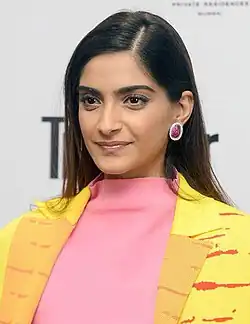 Kapoor in 2017
Kapoor in 2017
Sonam Kapoor Ahuja (pronounced [soːnəm kəˈpuːr]; born 9 June 1985) is an Indian actress who works in Hindi films. She has received several awards, including a National Film Award and a Filmfare Award. Kapoor appeared in Forbes India's Celebrity 100 list from 2012 to 2016.
Kapoor, the daughter of actor Anil Kapoor, began her career as an assistant director on filmmaker Sanjay Leela Bhansali's 2005 film Black. She made her acting debut in Bhansali's romantic drama Saawariya (2007), a box office flop, and had her first commercial success with the romantic comedy I Hate Luv Storys (2010). This was followed by a series of commercial failures and repetitive roles, which garnered her negative reviews. The 2013 box office hit Raanjhanaa marked a turning point in Kapoor's career, garnering her praise and Best Actress nominations at several award ceremonies. (Full article...) -
 Image 23
Image 23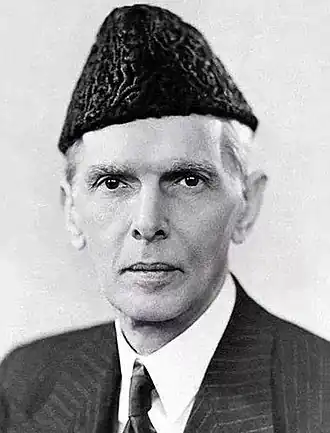 Formal portrait, c. 1945
Formal portrait, c. 1945
Muhammad Ali Jinnah (born Mahomedali Jinnahbhai; 25 December 1876 – 11 September 1948) was a barrister, politician, and the founder of Pakistan. Jinnah served as the leader of the All-India Muslim League from 1913 until the inception of Pakistan on 14 August 1947 and then as Pakistan's first governor-general until his death.
Born at Wazir Mansion in Karachi, Jinnah was trained as a barrister at Lincoln's Inn in London, England. Upon his return to India, he enrolled at the Bombay High Court, and took an interest in national politics, which eventually replaced his legal practice. Jinnah rose to prominence in the Indian National Congress in the first two decades of the 20th century. In these early years of his political career, Jinnah advocated for Hindu–Muslim unity, helping to shape the 1916 Lucknow Pact between the Congress and the All-India Muslim League, in which Jinnah had also become prominent. Jinnah became a key leader in the All-India Home Rule League, and proposed a fourteen-point constitutional reform plan to safeguard the political rights of Muslims in the Indian subcontinent. In 1920, however, Jinnah resigned from the Congress when it agreed to follow a campaign of satyagraha, which he regarded as political anarchy. (Full article...) -
![Image 24 Roshan in 2016 Hritik Rakesh Nagrath (born 10 January 1974), known professionally as Hrithik Roshan (Hindi: [ˈɾɪt̪ɪk ɾoːʃən];) is an Indian actor who works in Hindi cinema. Referred as the millenial superstar, he has portrayed a variety of characters and is known for his dancing skills. One of the highest-paid actors in India, he has won many awards, including six Filmfare Awards, of which four were for Best Actor. Starting from 2012, he has appeared in Forbes India's Celebrity 100 several times based on his income and popularity. Roshan has frequently collaborated with his father, Rakesh Roshan. He made brief appearances as a child actor in several films in the 1980s and later worked as an assistant director on four of his father's films. His first leading role was in the box-office success Kaho Naa... Pyaar Hai (2000), for which he received several awards. Performances in the 2000 terrorism drama Fiza and the 2001 ensemble family drama Kabhi Khushi Kabhie Gham... consolidated his reputation but were followed by several poorly received films. (Full article...)](./_assets_/Blank.png) Image 24
Image 24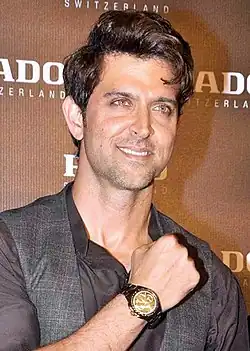 Roshan in 2016
Roshan in 2016
Hritik Rakesh Nagrath (born 10 January 1974), known professionally as Hrithik Roshan (Hindi: [ˈɾɪt̪ɪk ɾoːʃən];) is an Indian actor who works in Hindi cinema. Referred as the millenial superstar, he has portrayed a variety of characters and is known for his dancing skills. One of the highest-paid actors in India, he has won many awards, including six Filmfare Awards, of which four were for Best Actor. Starting from 2012, he has appeared in Forbes India's Celebrity 100 several times based on his income and popularity.
Roshan has frequently collaborated with his father, Rakesh Roshan. He made brief appearances as a child actor in several films in the 1980s and later worked as an assistant director on four of his father's films. His first leading role was in the box-office success Kaho Naa... Pyaar Hai (2000), for which he received several awards. Performances in the 2000 terrorism drama Fiza and the 2001 ensemble family drama Kabhi Khushi Kabhie Gham... consolidated his reputation but were followed by several poorly received films. (Full article...) -
 Image 25
Image 25_by_Erling_Mandelmann.jpg) Khan in 1991
Khan in 1991
Prince Sadruddin Aga Khan (17 January 1933 – 12 May 2003) was a French-born statesman and activist who served as United Nations High Commissioner for Refugees from 1966 to 1977, during which he reoriented the agency's focus beyond Europe and prepared it for an explosion of complex refugee issues. He was also a proponent of greater collaboration between non-governmental organizations (NGOs) and UN agencies. The Prince's interest in ecological issues led him to establish the Bellerive Foundation in the late 1970s, and he was a knowledgeable and respected collector of Islamic art.
Born in Paris, France, he was the son of Sir Sultan Mahomed Shah Aga Khan and Princess Andrée Aga Khan. He married twice, but had no children of his own. Prince Sadruddin died of cancer at the age of 70, and was buried in Switzerland. (Full article...)
Selected pictures
-
 Image 1Photograph: JJ HarrisonThe Siberian rubythroat (Luscinia calliope) is a small passerine bird generally considered to be an Old World flycatcher of the family Muscicapidae. This migratory insectivorous species breeds in mixed coniferous forest with undergrowth in Siberia, where it nests near the ground. It winters in Thailand, India and Indonesia. It is an extremely rare vagrant to Western Europe and the Aleutian Islands.
Image 1Photograph: JJ HarrisonThe Siberian rubythroat (Luscinia calliope) is a small passerine bird generally considered to be an Old World flycatcher of the family Muscicapidae. This migratory insectivorous species breeds in mixed coniferous forest with undergrowth in Siberia, where it nests near the ground. It winters in Thailand, India and Indonesia. It is an extremely rare vagrant to Western Europe and the Aleutian Islands. -
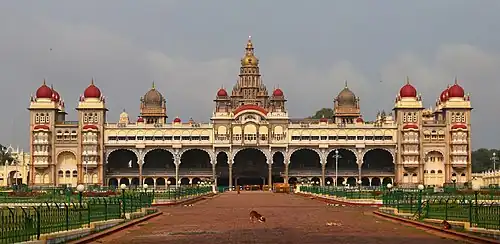 Image 2Photograph: Muhammad Mahdi KarimMysore Palace, the official residence and seat of the Wodeyars — the rulers of the Kingdom of Mysore. Located in southern India, the kingdom is traditionally believed to have been founded in 1399 as a vassal state to the Vijayanagara Empire before becoming independent in the 16th century.
Image 2Photograph: Muhammad Mahdi KarimMysore Palace, the official residence and seat of the Wodeyars — the rulers of the Kingdom of Mysore. Located in southern India, the kingdom is traditionally believed to have been founded in 1399 as a vassal state to the Vijayanagara Empire before becoming independent in the 16th century. -
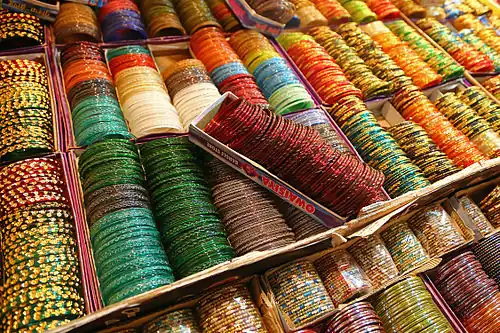 Image 3Photograph: Muhammad Mahdi KarimBangles on display in Bangalore, India. These rigid bracelets are usually made from metal, wood, or plastic and are traditionally worn by women in India, Nepal, Pakistan, and Bangladesh. In India, it is a common tradition to see a new bride wearing glass bangles at her wedding and the honeymoon will end when the last bangle breaks.
Image 3Photograph: Muhammad Mahdi KarimBangles on display in Bangalore, India. These rigid bracelets are usually made from metal, wood, or plastic and are traditionally worn by women in India, Nepal, Pakistan, and Bangladesh. In India, it is a common tradition to see a new bride wearing glass bangles at her wedding and the honeymoon will end when the last bangle breaks. -
Image 4Photograph: JkadavoorCupha erymanthis is a species of brush-footed butterfly found in forested areas of tropical South and Southeast Asia which may feed on liquids from carrion. This specimen was photographed in Kadavoor, Kerala, India.
-
.jpg) Image 5Photograph: Muhammad Mahdi KarimAn Indian palm squirrel (Funambulus palmarum) photographed in Bangalore, India. In India these squirrels are associated with the Hindu deity Rama, an avatar of Vishnu, and as such are not to be harmed. However, in Western Australia they are considered pests and at times targeted for eradication.
Image 5Photograph: Muhammad Mahdi KarimAn Indian palm squirrel (Funambulus palmarum) photographed in Bangalore, India. In India these squirrels are associated with the Hindu deity Rama, an avatar of Vishnu, and as such are not to be harmed. However, in Western Australia they are considered pests and at times targeted for eradication. -
_4.jpg) Image 6Photograph credit: Charles James SharpThe Indian rhinoceros (Rhinoceros unicornis) is a species of rhinoceros that once ranged across the entire northern part of the Indian subcontinent. As a result of habitat destruction and climatic changes, its range was gradually reduced such that, by the 19th century, it survived only in southern Nepal, northern Uttar Pradesh, northern Bihar, northern West Bengal, and in the Brahmaputra Valley in Assam. The species's range has since shrunk further, and its habitat is surrounded by human-dominated landscapes, so that in many areas, it occurs in cultivated areas, pastures, and secondary forests. It is currently listed as a vulnerable species on the IUCN Red List. This adult male Indian rhinoceros was photographed on the banks of the Gandaki River in Nepal.
Image 6Photograph credit: Charles James SharpThe Indian rhinoceros (Rhinoceros unicornis) is a species of rhinoceros that once ranged across the entire northern part of the Indian subcontinent. As a result of habitat destruction and climatic changes, its range was gradually reduced such that, by the 19th century, it survived only in southern Nepal, northern Uttar Pradesh, northern Bihar, northern West Bengal, and in the Brahmaputra Valley in Assam. The species's range has since shrunk further, and its habitat is surrounded by human-dominated landscapes, so that in many areas, it occurs in cultivated areas, pastures, and secondary forests. It is currently listed as a vulnerable species on the IUCN Red List. This adult male Indian rhinoceros was photographed on the banks of the Gandaki River in Nepal. -
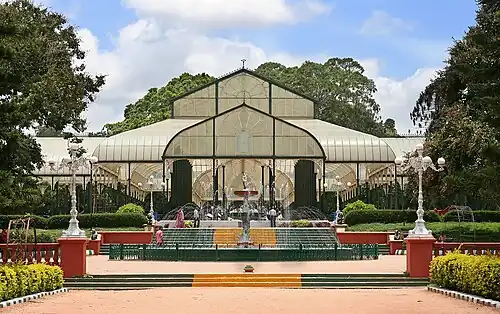 Image 7Photo: Muhammad Mahdi KarimThe glass house at Lal Bagh, a botanical garden in Bangalore, India. The garden was commissioned by the ruler of Mysore, Hyder Ali in 1760, and completed during the reign of his son Tipu Sultan. The glass house was modeled on London's Crystal Palace and constructed at the end of the 19th century.
Image 7Photo: Muhammad Mahdi KarimThe glass house at Lal Bagh, a botanical garden in Bangalore, India. The garden was commissioned by the ruler of Mysore, Hyder Ali in 1760, and completed during the reign of his son Tipu Sultan. The glass house was modeled on London's Crystal Palace and constructed at the end of the 19th century. -
_wb_edit.jpg) Image 8Photograph: Arthur Chapman; edit: Papa Lima Whiskey and Ryan KaldariBrahmaea wallichii, also known as the owl moth, is a moth from the family Brahmaeidae. With a wingspan of about 90–160 mm (3.5–6.3 in), it is one of the largest species of Brahmin moth. This nocturnal species is found in India, Bhutan, Myanmar, China, Taiwan and Japan.
Image 8Photograph: Arthur Chapman; edit: Papa Lima Whiskey and Ryan KaldariBrahmaea wallichii, also known as the owl moth, is a moth from the family Brahmaeidae. With a wingspan of about 90–160 mm (3.5–6.3 in), it is one of the largest species of Brahmin moth. This nocturnal species is found in India, Bhutan, Myanmar, China, Taiwan and Japan. -
 Image 9Painting: Raja Ravi Varma
Image 9Painting: Raja Ravi Varma -
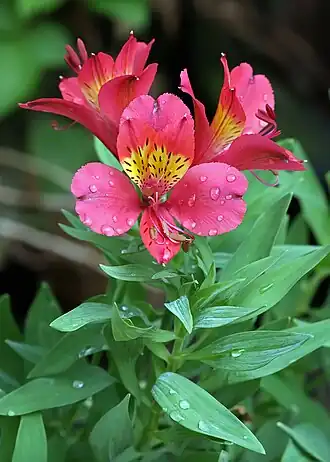 Image 10Photograph: Muhammad Mahdi KarimAlstroemeria × hybrida, an Alstroemeria hybrid, at the Lal Bagh Botanical Gardens in Bangalore, India. The genus consists of some 120 species and is native to South America.
Image 10Photograph: Muhammad Mahdi KarimAlstroemeria × hybrida, an Alstroemeria hybrid, at the Lal Bagh Botanical Gardens in Bangalore, India. The genus consists of some 120 species and is native to South America. -
.jpg) Image 11Photograph credit: Augustus BinuPomegranate juice is a beverage made from the fruit of the pomegranate. It is used in cooking both as a fresh juice and as a concentrated syrup. The fruit originated in the region extending from Iran to northern India and has been cultivated since ancient times. The fruit has a hard outer husk and a spongy mesocarp in which the seeds in their fleshy seedcoats are embedded. Pomegranate juice can be sweet or sour, but most fruits are moderate in taste. The juice has long been a popular drink in Europe and the Middle East, and is now widely distributed in the United States and Canada.
Image 11Photograph credit: Augustus BinuPomegranate juice is a beverage made from the fruit of the pomegranate. It is used in cooking both as a fresh juice and as a concentrated syrup. The fruit originated in the region extending from Iran to northern India and has been cultivated since ancient times. The fruit has a hard outer husk and a spongy mesocarp in which the seeds in their fleshy seedcoats are embedded. Pomegranate juice can be sweet or sour, but most fruits are moderate in taste. The juice has long been a popular drink in Europe and the Middle East, and is now widely distributed in the United States and Canada. -
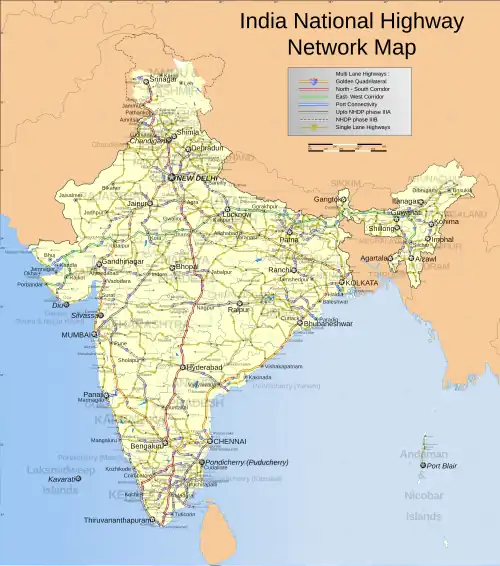 Image 12Map credit: PlaneMadA map of Network of National Highways in India, including NHDP projects up to phase IIIB, which is due to be completed by December 2012. The National Highways are the main long-distance roadways and constitute a total of about 58,000 km (36,250 mi), of which 4,885 km (3,053 mi) are central-separated expressways. Highways in India are around 2% of the total road network in India, but carry nearly 40% of the total road traffic.
Image 12Map credit: PlaneMadA map of Network of National Highways in India, including NHDP projects up to phase IIIB, which is due to be completed by December 2012. The National Highways are the main long-distance roadways and constitute a total of about 58,000 km (36,250 mi), of which 4,885 km (3,053 mi) are central-separated expressways. Highways in India are around 2% of the total road network in India, but carry nearly 40% of the total road traffic. -
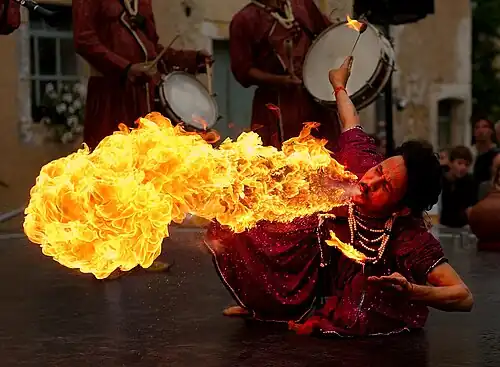 Image 13Photo credit: Luc ViatourA fire breather in the "Jaipur Maharaja Brass Band" of India. Fire breathing, which is said to have originated in India, is the act of creating a large flame by spraying, with one's mouth, a flammable liquid upon an open flame. A number of legendary creatures are said to possess innate capabilities for fire breathing, most notably dragons.
Image 13Photo credit: Luc ViatourA fire breather in the "Jaipur Maharaja Brass Band" of India. Fire breathing, which is said to have originated in India, is the act of creating a large flame by spraying, with one's mouth, a flammable liquid upon an open flame. A number of legendary creatures are said to possess innate capabilities for fire breathing, most notably dragons. -
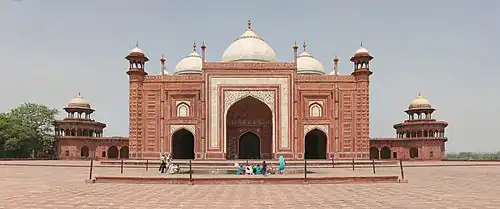 Image 14Photo: Muhammad Mahdi KarimThe mosque at the Taj Mahal complex in Agra, India. This red sandstone building, on the western side of the complex, faces the west side of the mausoleum. In the forefront is a howz, meant for ablution. On the eastern side of the complex is the jawab ("answer"), a mirror image of the mosque except for the missing mihrab and different floor pattern; this jawab was mainly intended for architectural balance. Both were constructed in 1643.
Image 14Photo: Muhammad Mahdi KarimThe mosque at the Taj Mahal complex in Agra, India. This red sandstone building, on the western side of the complex, faces the west side of the mausoleum. In the forefront is a howz, meant for ablution. On the eastern side of the complex is the jawab ("answer"), a mirror image of the mosque except for the missing mihrab and different floor pattern; this jawab was mainly intended for architectural balance. Both were constructed in 1643. -
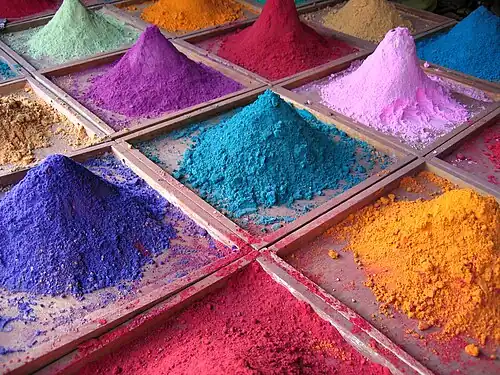 Image 15Photo credit: Dan BradyPigments for sale at a market stall in Goa, India. Many pigments used in manufacturing and the visual arts are dry colourants, ground into a fine powder. This powder is then added to a vehicle or matrix, a relatively neutral or colorless material that acts as a binder, before it is applied. Unlike a dye, a pigment generally is insoluble.
Image 15Photo credit: Dan BradyPigments for sale at a market stall in Goa, India. Many pigments used in manufacturing and the visual arts are dry colourants, ground into a fine powder. This powder is then added to a vehicle or matrix, a relatively neutral or colorless material that acts as a binder, before it is applied. Unlike a dye, a pigment generally is insoluble.
 Featured list –
Featured list –
-
 Image 1
Image 1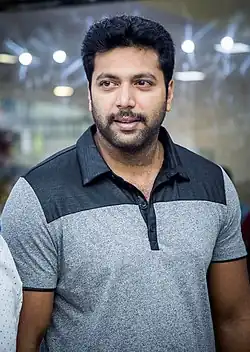
Thani Oruvan is a 2015 Indian Tamil-language action thriller film directed by Mohan Raja, who also co-wrote the screenplay and dialogues with the duo Subha. The film features Jayam Ravi, Arvind Swami and Nayanthara in the lead roles. Thambi Ramaiah, Ganesh Venkatraman, Mugdha Godse and Nassar play supporting roles. The film's story focuses on Mithran (Ravi), an IPS officer, who learns of the plans of scientist and businessman Siddharth Abhimanyu (Swami) to sabotage a deal to make generic medicines available at low cost for poor people. Siddharth succeeds in his plan and begins indulging in a game of cat and mouse with Mithran. The rest of the story revolves around how Mithran overcomes the obstacles set by Siddharth. Produced by Kalpathi S. Aghoram, Kalpathi S. Ganesh and Kalpathi S. Suresh under their company AGS Entertainment, the film's soundtrack and score were composed by Hiphop Tamizha. Ramji and Gopi Krishna handled the cinematography and editing respectively.
Made on a budget of ₹200 million, Thani Oruvan was released on 28 August 2015 and received positive reviews. It was commercially successful, grossing ₹1.05 billion worldwide. The film won 21 awards from 37 nominations; its direction, story, screenplay, performances of the cast members and music have received the most attention from award groups. (Full article...) -
 Image 2
Image 2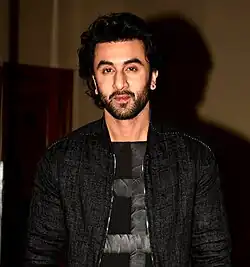
Barfi! is a 2012 Indian romantic comedy-drama film written and directed by Anurag Basu and produced by UTV Motion Pictures. The film features Ranbir Kapoor, Priyanka Chopra, and Ileana D'Cruz in the lead roles, with Saurabh Shukla, Ashish Vidyarthi, and Roopa Ganguly playing supporting roles. The screenplay which incorporates a nonlinear narrative was co-written by Basu with his wife Tani. Pritam Chakraborty composed the musical and background score while Akiv Ali edited the film, with the cinematography provided by Ravi Varman. Set between 1972 and 2012, the film narrates the story of the title character from Darjeeling and his relationships with two women, Shruti and the autistic Jhilmil.
Made on a budget of approximately ₹410 million (US$4.8 million), Barfi! opened worldwide on 14 September 2012 to widespread critical acclaim. It was a major commercial success, grossing ₹1.88 billion (US$22 million) at the box office. Barfi! has received various awards and nominations, with praise for its direction, the cast's performances, cinematography, screenplay, musical score, costume and production design. As of June 2015, the film has won 70 awards. (Full article...) -
 Image 3
Image 3
Antennas at a ham operator's station in Chennai, India.
Amateur radio or ham radio is a hobby that is practised by over 16,000 licensed users in India.
Licences are granted by the Wireless and Planning and Coordination Wing (WPC), a branch of the Ministry of Communications and Information Technology. In addition, the WPC allocates frequency spectrum in India. The Indian Wireless Telegraphs (Amateur Service) Rules, 1978 lists five licence categories.
To obtain a licence, candidates must pass the Amateur Station Operator's Certificate examination conducted by the WPC. The examination consists of two 50-mark written sections: Radio theory and practice, Regulations; and a practical test consisting of a demonstration of Morse code proficiency in sending and receiving. After passing the examination, the candidate must clear a police interview. After clearance, the WPC grants the licence along with the user-chosen call sign. This procedure can take up to one year. This licence is valid for up to five years. (Full article...) -
 Image 4
Image 4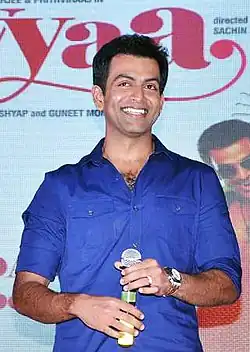 Prithviraj Sukumaran is the recent winner in 2024
Prithviraj Sukumaran is the recent winner in 2024
The Kerala State Film Award for Best Actor is an award, begun in 1969, presented annually at the Kerala State Film Awards of India to an actor for best performance in a Malayalam film. Until 1997, the awards were managed directly by the Department of Cultural Affairs of the Government of Kerala. Since 1998, the awards have been constituted by the Kerala State Chalachitra Academy, an autonomous, non-profit institution functioning under the Department of Cultural Affairs. The awardees are decided by a jury constituted every year. They are announced by the Minister for Cultural Affairs and are presented by the Chief Minister.
Throughout the years, accounting for ties and repeat winners, the government has presented 54 Best Actor awards to 35 actors. The recipients receive a figurine, a certificate, and a cash prize of ₹100,000 (US$1,200). Several actors have won the honour for more than one film in a given year. As of 2020, the only actor to have won the prize in consecutive years is Bharat Gopy, in 1982 and 1983. (Full article...) -
 Image 5
Image 5 Kajol in 2024
Kajol in 2024
Kajol is an Indian actress known for her work in Hindi films. She is a recipient of more than 40 accolades into her credit. Six Filmfare Awards, one Best Performance in a Negative Role for Gupt: The Hidden Truth and record-tying five Best Actress for the romance musicals Dilwale Dulhania Le Jayenge, Kuch Kuch Hota Hai, the family drama Kabhi Khushi Kabhie Gham, the tragedy romantic thriller Fanaa and the social drama My Name Is Khan. In addition to seven nominations. She has received five Screen Awards, four Zee Cine Awards, two Bollywood Movie Award, and one each Stardust Award and Bengal Film Journalists' Association Awards.
Kajol made her acting debut with Bekhudi (1992), and had commercial successes in Baazigar (1993), and Yeh Dillagi (1994). Starring roles in the top-grossing romances Dilwale Dulhania Le Jayenge (1995) and Kuch Kuch Hota Hai (1998) established her as a leading star in the 1990s and earned her two Filmfare Awards for Best Actress.
After making her debut in 1992 with the romance Bekhudi, Kajol received critical acclaim and the Bengal Film Journalists' Association Award for Best Actress for playing an orphaned girl in Udhaar Ki Zindagi (1994). She won her first Filmfare Award for Best Actress for her portrayal of an Indian non-resident in the romantic drama Dilwale Dulhania Le Jayenge (1995), and Best Performance in a Negative Role for her performance as a femme fatale in the psychological thriller Gupt: The Hidden Truth (1997), becoming the first actress to win in the latter category. Additionally, she received the Zee Cine Award for Best Actor – Female for Gupt. (Full article...) -
 Image 6
Image 6
Dil Dhadakne Do (transl. Let the Heart Beat) is a 2015 Indian comedy-drama film directed by Zoya Akhtar. Produced by Ritesh Sidhwani and Farhan Akhtar, the film features an ensemble cast consisting of Anil Kapoor, Shefali Shah, Priyanka Chopra, Ranveer Singh, Anushka Sharma and Farhan Akhtar. The supporting cast also includes Rahul Bose, Zarina Wahab, Vikrant Massey, Ridhima Sud, Pawan Chopra, Parmeet Sethi, Dolly Mattdo and Manoj Pahwa. Akhtar co-wrote the screenplay with her friend and longtime collaborator Reema Kagti. The soundtrack was composed by the trio Shankar–Ehsaan–Loy while the cinematography was provided by Carlos Catalan. Anand Subaya and Manan Mehta edited the film.
The film tells the story of the Mehras, a dysfunctional Punjabi family who invite their family and friends along on a cruise trip to celebrate the parents' 30th wedding anniversary. Dil Dhadakne Do was released worldwide on 5 June 2015 to positive reviews from critics. The film grossed ₹1.45 billion at global box office on a budget of ₹580 million. The film garnered awards and nominations in a variety of categories with particular praise for Akhtar's direction, the performances, the music and costume design. (Full article...) -
 Image 7The state president of the Indian National Congress is the state-level highest command of the Indian National Congress (INC), responsible for leading in political campaigns at state level. State presidents shoulder a diverse array of roles and responsibilities integral to the effective functioning of the party at the state-level. Also known as the leader of the state and union territory party, a state president is appointed by the national president of the party.
Image 7The state president of the Indian National Congress is the state-level highest command of the Indian National Congress (INC), responsible for leading in political campaigns at state level. State presidents shoulder a diverse array of roles and responsibilities integral to the effective functioning of the party at the state-level. Also known as the leader of the state and union territory party, a state president is appointed by the national president of the party.
Being the higher decision-making body, state presidents actively contribute to the formulation of state-level policies, representing the party's stance on relevant issues and engaging in the development and implementation of election strategies during state elections. In addition, a state president is tasked with overseeing the organizational structure of the Pradesh Congress Committee, including the appointment and coordination of leaders at various levels, such as the district committee, block committee, and each panchayat development block or panchayat samiti. Serving as a spokesperson for the party in the state, they communicate the party's positions to the media and keep party members informed about policies and decisions. State presidents also play a pivotal role in building and maintaining the party's membership, reaching out to diverse sections of society and addressing their concerns to advance the party's agenda. (Full article...) -
 Image 8The Pampa Award (or Pampa Prashasti) is a literary award in the Indian state of Karnataka. The award was established in 1987 by the government of Karnataka. It is the highest literary honor conferred by the Department of Kannada and Culture, Government of Karnataka State, and recognises works written in the Kannada language (1 of the 22 official languages of India).
Image 8The Pampa Award (or Pampa Prashasti) is a literary award in the Indian state of Karnataka. The award was established in 1987 by the government of Karnataka. It is the highest literary honor conferred by the Department of Kannada and Culture, Government of Karnataka State, and recognises works written in the Kannada language (1 of the 22 official languages of India).
The award is named after the first Kannada poet Adikavi Pampa. The award originally comprised a cash prize of ₹1 lakh (US$1,200), a shawl, a citation and a memento. The cash prize was increased to ₹3 lakh (US$3,500) in 2008. Prior to 1996, the awards were given for a best single work by a Kannada writer. Since then, the award has been given to writers for their lifetime contribution to the Kannada literature. The Pampa Prashasti is presented by the Chief Minister, during the Kadambotsava, a cultural festival held annually in Pampa's hometown of Banavasi in Uttara Kannada district. (Full article...) -
 Image 9
Image 9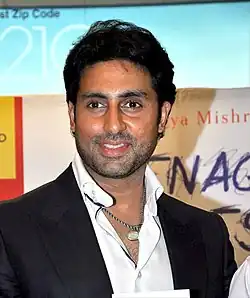
Bachchan in 2013
Abhishek Bachchan is an Indian actor and film producer known for his work in Hindi films. He made his acting debut opposite Kareena Kapoor in J. P. Dutta's war drama Refugee (2000), where his portrayal of the titular unnamed refugee earned a nomination for the Filmfare Best Male Debut Award. However, his subsequent films failed at the box office°, including Bas Itna Sa Khwaab Hai (2001), and Shararat (2002). His career prospects improved in 2004, when he played a gangster in Mani Ratnam's political drama Yuva and a police officer in Sanjay Gadhvi's action thriller Dhoom. The former won him his first Filmfare Award for Best Supporting Actor, and the latter became one of the highest-grossing films of the year and his first commercial success.
In 2005, Bachchan teamed up with his father twice in Ram Gopal Varma's thriller Sarkar and the crime comedy Bunty Aur Babli. The latter was the second highest-grossing film of the year, and his performance in Sarkar earned him a second Filmfare Award for Best Supporting Actor. That same year, he appeared in the Bengali film Antarmahal (2005). 2006 proved to be key for Bachchan, as he received his third consecutive Filmfare Award for Best Supporting Actor for his performance in Karan Johar's musical romantic drama Kabhi Alvida Naa Kehna (2006), and reprised his role in the action sequel Dhoom 2 (2006), which became the highest-grossing Bollywood film to that point. Bachchan next starred alongside Aishwarya Rai in Ratnam's critically and commercially successful drama Guru (2007), a biopic inspired by the life of businessman Dhirubhai Ambani. His title role in the film was positively received. (Full article...) -
 Image 10
Image 10.jpg)
Bhatt at an event for RRR in 2021
Alia Bhatt is a British actress of Indian descent who predominantly works in Hindi films. As a child, she played a minor role in her father Mahesh Bhatt's production Sangharsh (1999), as the younger version of star Preity Zinta's character. In 2012, Bhatt had her first lead role in Karan Johar's teen film Student of the Year, but her performance in it was not well received. Two years later, she gained praise for playing a kidnapping victim in the drama Highway (2014), winning the Filmfare Critics Award for Best Actress. In the same year, her starring roles in the commercially successful romances 2 States and Humpty Sharma Ki Dulhania, both produced under Johar's studio Dharma Productions, established her as a leading actress. She also sang the single "Samjhawan Unplugged" for the latter film's soundtrack.
In Bhatt's three film releases of 2016—Kapoor & Sons, Dear Zindagi, and Udta Punjab—she played young women in troubling circumstances. Her performance in the last of these won her the Filmfare Award for Best Actress. Following another romantic role in Badrinath Ki Dulhania (2017), she played a spy in the thriller Raazi (2018) and a volatile girlfriend in the musical drama Gully Boy (2019). She won two more Best Actress awards at Filmfare for the latter two. This was followed by two poorly received films, Kalank (2019) and Sadak 2 (2020). Bhatt gained further success in 2022 with a brief role in the Telugu period film RRR, and starring roles in the fantasy film Brahmāstra: Part One – Shiva and biopic Gangubai Kathiawadi, in which she starred as the titular prostitute; all three rank among the highest-grossing Indian films of the year. She won the National Film Award for Best Actress and her fourth Best Actress award at Filmfare for the last of these. She also produced and starred in the Netflix black comedy Darlings under her company Eternal Sunshine Productions, for which she received a Filmfare OTT Award. (Full article...) -
 Image 11The National Film Award for Best Direction is an honour presented annually at India's National Film Awards ceremony by the National Film Development Corporation of India (NFDC), an organisation set up by the Indian Ministry of Information and Broadcasting. Since 1967, the award is given by a national panel appointed annually by the NFDC to a director for their work within Indian cinema. It is presented by the president of India at a ceremony held in New Delhi.
Image 11The National Film Award for Best Direction is an honour presented annually at India's National Film Awards ceremony by the National Film Development Corporation of India (NFDC), an organisation set up by the Indian Ministry of Information and Broadcasting. Since 1967, the award is given by a national panel appointed annually by the NFDC to a director for their work within Indian cinema. It is presented by the president of India at a ceremony held in New Delhi.
The winner is given a "Swarna Kamal" (Golden Lotus) certificate and a cash prize of ₹3,00,000. Including ties and repeat winners, the NFDC has presented a total of 53 Best Direction awards to 34 different directors. Although Indian cinema produces films in more than twenty languages, the performances of films that have won awards are of nine languages: Bengali (16 awards), Malayalam (14 awards), Hindi (11 awards), Tamil (4 awards), English, Kannada and Marathi (3 awards each), Assamese and Punjabi (1 each). (Full article...) -
 Image 12
Image 12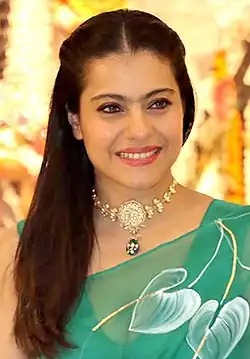
Kajol in 2021
Kajol is an Indian actress who is known for her work in Hindi films. She made her screen debut in the 1992 film Bekhudi. She was noted for her performance and went on to sign the 1993 commercially successful thriller Baazigar opposite Shah Rukh Khan. She starred in the 1994 film Udhaar Ki Zindagi, which earned her critical acclaim. This was followed by a role in Yeh Dillagi alongside Akshay Kumar and Saif Ali Khan. Kajol featured in five films in 1995. She appeared briefly in the thriller Karan Arjun, and played Simran, an NRI in Aditya Chopra’s romance Dilwale Dulhania Le Jayenge, both of which ranked among the highest-grossing Bollywood films of the year, and the success of the latter established her career in Bollywood. As of 2021, Dilwale Dulhania Le Jayenge is the longest-running Indian film. Also in 1995, she appeared in the box-office flops Hulchul and Gundaraj. Her only screen appearance of 1996 was in Bambai Ka Babu, a financial failure.
In 1997, Kajol featured in the film Minsara Kanavu, her first Tamil feature. She played an obsessive lover in the mystery film Gupt (1997), and became the first woman to win the Filmfare Award for Best Performance in a Negative Role. Later in 1997, she featured as a poor girl in the romantic film Ishq, a box-office hit. In 1998, she played the leading lady in three romantic comedies, which were among the top-grossing Bollywood productions of the year — Pyaar Kiya To Darna Kya, Pyaar To Hona Hi Tha, and Kuch Kuch Hota Hai. Also in 1998, she played dual roles in the drama Dushman. The following year, she played the secret lover of Ajay Devgn's character in Dil Kya Kare and starred in the commercially successful film Hum Aapke Dil Mein Rehte Hain opposite Anil Kapoor. Following this, she starred in the films Raju Chacha (2000) and Kuch Khatti Kuch Meethi (2001), both of which performed poorly at the box-office. (Full article...) -
 Image 13
Image 13_(cropped).jpg)
James Faulkner is one of the only four bowlers to take multiple five-wicket hauls and the only to take multiple five-wicket hauls in the same season.
In cricket, a five-wicket haul (also known as a "five-for" or "fifer") refers to a bowler taking five or more wickets in a single innings. This is regarded as a notable achievement, especially in T20 cricket where a bowler can bowl a maximum of only 24 balls (4 overs). The Indian Premier League (IPL) is a professional Twenty20 cricket league in India, which has been held annually since its first season in 2008. So far, 37 five-wicket hauls have been taken by different bowlers, of which only two five-wicket hauls have been taken outside India. Players from twelve of the thirteen teams have taken five-wicket hauls; Kochi Tuskers Kerala is the only franchise for which a player has not taken a five-wicket haul.
The first five-wicket haul was taken by Sohail Tanvir of the Rajasthan Royals against the Chennai Super Kings on 4 May 2008. He finished the game with 6 wickets. The most economical five-wicket haul was taken by Akash Madhwal of the Mumbai Indians, who claimed five wickets with an economy rate of 1.43 in the 2023 season. Yuzvendra Chahal of the Rajasthan Royals took the least economical five-wicket haul, 5/40 bowling with an economy rate of 10.00 in 2021. Anil Kumble is the oldest bowler to take a five-wicket haul, achieving the feat at the age of 38, while Jaydev Unadkat is the youngest, he was 21 when he took his first five-for in 2013. (Full article...) -
 Image 14
Image 14.jpg)
Khan at the Marrakech International Film Festival in 2012
Shah Rukh Khan is an Indian actor, film producer, and television personality predominantly known for his work in Bollywood. He is regarded as one of the biggest and most successful film stars in the world. He is the recipient of several awards, including a National Film Award, 15 Filmfare Awards, Screen Awards, Zee Cine Awards, and IIFA Awards. Besides acting awards, he has received a number of state honours, including the Padma Shri by the Government of India in 2005, the Ordre des Arts et des Lettres in 2007, and the Legion of Honour in 2014 (both by the Government of France).
Khan made his acting debut with a leading role in the romantic drama Deewana (1992), which won him the Filmfare Award for Best Male Debut. The next year he won his first Best Actor trophy for his portrayal of a murderer in Baazigar, and a Best Performance in a Negative Role nomination (both at Filmfare) for his performance as an obsessive lover in Darr. Khan's most significant release of the 1990s was Dilwale Dulhania Le Jayenge. He portrayed a non-resident Indian who falls in love with the character played by Kajol, for which he earned another Filmfare Award for Best Actor as well as his first Screen Award. Khan later won two consecutive Filmfare Awards in the Best Actor category for his performances in Dil To Pagal Hai (1997) and Kuch Kuch Hota Hai (1998), both films focusing on a love quadrangle. (Full article...) -
 Image 15
Image 15
Chopra Jonas in 2019
Priyanka Chopra is an Indian actress, known for her roles in Hindi and English films. Chopra made her acting debut with the 2002 Tamil film Thamizhan. She made her Bollywood debut the following year with the spy thriller The Hero: Love Story of a Spy. The same year, Chopra's role in the box-office hit romance Andaaz won her the Filmfare Award for Best Female Debut and her first Filmfare Award for Best Supporting Actress nomination. In 2004, she starred in the commercially successful romantic comedy Mujhse Shaadi Karogi and garnered high critical acclaim for her breakthrough role in the romantic thriller Aitraaz which earned her the Filmfare Award for Best Performance in a Negative Role and a second Best Supporting Actress nomination. Chopra starred in six films in 2005, including Waqt and Bluffmaster!. In 2006, she starred in two of the highest-grossing films of the year—the superhero film Krrish and the action thriller Don.
In 2007 and 2008, Chopra starred in several critical and commercial failures, but in late 2008, her role in the acclaimed drama Fashion proved to be a turning point in her career. Her portrayal of a troubled model won her the National Film Award for Best Actress and the Filmfare Award for Best Actress. In 2009, Chopra starred in Vishal Bhardwaj's acclaimed caper thriller Kaminey, and played twelve distinct characters in the romantic comedy What's Your Raashee?. She won the Filmfare Award for Best Actress (Critics) for her portrayal of a serial killer in Bhardwaj's 2011 black comedy 7 Khoon Maaf. (Full article...) -
 Image 16
Image 16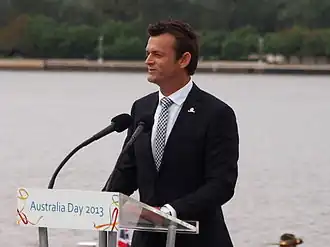
Adam Gilchrist was a captain of KXIP in 2011–2013.
Punjab Kings, formerly called Kings XI Punjab (KXIP), is a franchise cricket team based in Mohali, Punjab in India, and is one of the teams participating in the Indian Premier League (IPL). KXIP was founded in 2008. The franchise is owned by actress Preity Zinta, Ness Wadia of Bombay Dyeing, Karan Paul of the Apeejay Surendera Group and Mohit Burman of Dabur. The group paid US$76 million to acquire the franchise. It is owned by a consortium, along with the Rajasthan Royals. Along with the Rajasthan Royals, KXIP's franchise agreement was terminated by the Board of Control for Cricket in India (BCCI) in October 2010, because the teams had been signed by people who were not members of the consortium which owned the team. A petition of arbitration (appeal) was filed to the Bombay High Court in November 2010, challenging the decision, which was accepted a month later.
KXIP played their first Twenty20 match in 2008 during the first season of the IPL, where they reached the semi-final. They lost the 2008 semi-final to Chennai Super Kings on 31 May 2008, after playing fourteen matches in the league, winning ten matches and losing four. With ten international cricketers in 2009, they finished fifth in the second season of the IPL, winning and losing seven matches. KXIP finished in eighth place in the third IPL season, losing eleven of their fourteen matches. KXIP improved in the fourth season of the IPL, finishing in fifth place with seven losses and victories. In the IPL's fifth season in 2012, the team played sixteen matches, winning eight and losing nine to finish in sixth position. In the 2013 season, they won eight matches out of sixteen, and lost the other eight. In the 2014 season, they won 11 of 14 matches. In the 2015 season, KXIP won three of fourteen matches and finished in last position. In the IPL's ninth season, KXIP won four of fourteen matches and finished in last position. In the 2017 season, KXIP won seven of fourteen matches to finish in fifth position. (Full article...) -
 Image 17
Image 17 Mikoyan MiG-29K in flight over Indian islands
Mikoyan MiG-29K in flight over Indian islands
The Indian Navy currently operates twenty-five air squadrons. Of these, eleven operate fixed-wing aircraft, ten are helicopter squadrons and the remaining three are equipped with unmanned aerial vehicles (UAV). Building on the legacy inherited from the Royal Navy prior to Indian independence, the concept of naval aviation in India started with the establishment of Directorate of Naval Aviation at Naval Headquarters (NHQ) in early 1948. Later that year officers and sailors from the Indian Navy were sent to Britain for pilot training. In 1951, the Fleet Requirement Unit (FRU) was formed to meet the aviation requirements of the navy. On 1 January 1953, the charge of Cochin airfield was handed over to the navy from the Directorate General of Civil Aviation. On 11 March, the FRU was commissioned at Cochin with ten newly acquired Sealand aircraft. The navy's first air station, INS Garuda, was commissioned two months later. From February 1955 to December 1958, ten Firefly aircraft were acquired. To meet the training requirements of the pilots, the indigenously developed HAL HT-2 trainer was inducted into the FRU. On 17 January 1959, the FRU was commissioned as Indian Naval Air Squadron (INAS) 550, to be the first Indian naval air squadron. In the following two years, three more naval air squadrons—INAS 300, INAS 310 and INAS 551—were commissioned. The first two operated from the newly purchased aircraft carrier INS Vikrant flying Sea Hawks and Alizés, whereas the latter one, equipped with Vampires, was used for training purposes.
Between 1961 and 1971, three helicopter squadrons were commissioned—INAS 321, INAS 330 and INAS 561. The first two were equipped with HAL Chetak and Sea King 42Bs for search and rescue and anti-submarine roles respectively, whereas the later one assumed a training role. In December 1971, the squadrons embarked on the aircraft carrier INS Vikrant saw action in the 1971 Indo-Pakistani War. Between 1976 and 1977, INAS 312 and INAS 315 were commissioned with Super Constellation and Ilyushin Il-38s respectively. In December 1980, another helicopter squadron intended for anti-submarine warfare—INAS 333—was commissioned. It was initially equipped with Ka-25s, and with Ka-28s in late 1980s. In 1984, one patrol and one helicopter squadron—INAS 318 and INAS 336—were commissioned. The patrol squadron was initially equipped with Islander aircraft, but they were replaced by Dornier 228s in 2000. In November 1990, another Sea King squadron—INAS 339—was commissioned. Later in 1993, the Sea Kings were replaced by Ka-28s, and in 2003, Ka-31s were inducted, making it the only Indian naval air squadron for the role of airborne early warning and control. (Full article...) -
 Image 18
Image 18_2.jpg)
Members of the Indian cricket team before a Women's World Twenty20 game in Sydney, 2009.
A women's Twenty20 International (WT20I) is a 20 overs-per-side cricket match played in a maximum of 150 minutes between two ICC member sides, and is played under the rules of Twenty20 cricket. The first such match was held in August 2004 between England and New Zealand. The India women's national cricket team played its first WT20I against England in August 2006; India won the match by eight wickets.
Since the team made its first WT20I appearance in 2006, 73 players—including five different captains—have represented India in the format. The list is arranged in the order in which each player won her first Twenty20 cap. Where more than one player won her first Twenty20 cap in the same match, those players are listed alphabetically by surname. (Full article...) -
 Image 19
Image 19
Kaif in 2016
Katrina Kaif is a British actress who predominantly appears in Bollywood films. She made her film debut in the 2003 heist film Boom, a box office bomb. She then played the titular princess in the Telugu film Malliswari (2004). Kaif had her first success in Bollywood when she appeared opposite Salman Khan in David Dhawan's romantic comedy Maine Pyaar Kyun Kiya?. The 2006 musical romance Humko Deewana Kar Gaye saw Kaif pair opposite Akshay Kumar for the first of many films, though the film was a critical and financial failure. Beginning with Namastey London, the year 2007 marked a turning point in her career when all four releases proved to be successful at the box-office. Among these were two of the highest grossing productions of the year, the comedies Partner and Welcome. following year, Kaif appeared in three films including the action comedy Singh Is Kinng.
In 2009, Kaif received a nomination for the Filmfare Award for Best Actress for her performance in Kabir Khan's terrorism drama New York. Later that year, she starred opposite Ranbir Kapoor in the comedy Ajab Prem Ki Ghazab Kahani. In 2010, Kaif portrayed the role of a politician in Prakash Jha's political thriller Raajneeti and an aspiring actress in Tees Maar Khan. While the former was a box-office hit, the latter was a critical and commercial failure. Kaif starred alongside an ensemble cast in Zoya Akhtar's comedy drama Zindagi Na Milegi Dobara (2011). She received her second Filmfare Award nomination for Best Actress for her portrayal of a runaway bride in the romantic comedy Mere Brother Ki Dulhan (2011). (Full article...) -
 Image 20Enthiran (transl. Robot) is a 2010 Indian Tamil-language science fiction film directed by S. Shankar and produced by Kalanithi Maran. Shankar wrote the screenplay and co-wrote the dialogues with Sujatha and Madhan Karky. The film stars Rajinikanth and Aishwarya Rai with Danny Denzongpa, Santhanam, and Karunas playing supporting roles. The musical score was composed by A. R. Rahman while the cinematography, visual effects, editing, and art direction were handled by R. Rathnavelu, V. Srinivas Mohan, Anthony, and Sabu Cyril respectively. The film's story revolves around a scientist's struggle to control his creation, an android robot whose software is upgraded to give it the ability to comprehend and generate human emotions. The plan backfires when the robot falls in love with the scientist's fiancée and is further manipulated by a rival scientist to bring destruction to all who stand in its way. The film was dubbed into Hindi as Robot.
Image 20Enthiran (transl. Robot) is a 2010 Indian Tamil-language science fiction film directed by S. Shankar and produced by Kalanithi Maran. Shankar wrote the screenplay and co-wrote the dialogues with Sujatha and Madhan Karky. The film stars Rajinikanth and Aishwarya Rai with Danny Denzongpa, Santhanam, and Karunas playing supporting roles. The musical score was composed by A. R. Rahman while the cinematography, visual effects, editing, and art direction were handled by R. Rathnavelu, V. Srinivas Mohan, Anthony, and Sabu Cyril respectively. The film's story revolves around a scientist's struggle to control his creation, an android robot whose software is upgraded to give it the ability to comprehend and generate human emotions. The plan backfires when the robot falls in love with the scientist's fiancée and is further manipulated by a rival scientist to bring destruction to all who stand in its way. The film was dubbed into Hindi as Robot.
Produced on an estimated budget of ₹1.32 billion, Enthiran was released on 1 October 2010 and yielded a revenue of ₹1.79 billion according to a report by the Sun TV Network. The film garnered awards and nominations in several categories, with particular praise for its cinematography, visual effects, art direction, costume design, and Rajinikanth's performance. The film has won 25 awards from 38 nominations. (Full article...) -
 Image 21
Image 21.jpg) The 2022 recipient: Mithun Chakraborty
The 2022 recipient: Mithun Chakraborty
The Dadasaheb Phalke Award is India's highest award in the field of cinema, given by the Government of India and presented annually at the National Film Awards. The recipient is honoured for their "outstanding contribution to the growth and development of Indian cinema" and is selected by a committee consisting of eminent personalities from the Indian film industry. The award comprises a Swarna Kamal (Golden Lotus) medallion, a shawl, and a cash prize of ₹1,000,000 (US$12,000).
Presented first in 1969, the award was introduced by the Government of India to commemorate Dadasaheb Phalke's contribution to Indian cinema. Phalke (1870–1944), who is popularly known as and often regarded as "the father of Indian cinema", was an Indian filmmaker who directed India's first full-length feature film, Raja Harishchandra (1913). (Full article...) -
 Image 22Zindagi Na Milegi Dobara (English: You Live Only Once) is a 2011 Indian coming-of-age film directed by Zoya Akhtar, who also co-wrote the film along with Reema Kagti. It is produced by Excel Entertainment. The film stars an ensemble cast of Hrithik Roshan, Abhay Deol and Farhan Akhtar, with Katrina Kaif and Kalki Koechlin in supporting roles. The musical score for the film was composed by the trio Shankar–Ehsaan–Loy. Its cinematography was provided by Carlos Catalan. The film narrates the story of three friends on a bachelor trip and how each of them discover themselves and overcome their problems and insecurities.
Image 22Zindagi Na Milegi Dobara (English: You Live Only Once) is a 2011 Indian coming-of-age film directed by Zoya Akhtar, who also co-wrote the film along with Reema Kagti. It is produced by Excel Entertainment. The film stars an ensemble cast of Hrithik Roshan, Abhay Deol and Farhan Akhtar, with Katrina Kaif and Kalki Koechlin in supporting roles. The musical score for the film was composed by the trio Shankar–Ehsaan–Loy. Its cinematography was provided by Carlos Catalan. The film narrates the story of three friends on a bachelor trip and how each of them discover themselves and overcome their problems and insecurities.
Made on a budget of ₹550 million (US$6.5 million), Zindagi Na Milegi Dobara was released on 5 July 2011 and grossed over ₹1.53 billion (US$18 million) worldwide. Rotten Tomatoes, a review aggregator, surveyed 7 reviews and judged 100 percent to be positive. The film garnered awards and nominations in several categories, with particular praise for its direction, screenplay, and the performances of its cast. As of 2015, the film has won 33 awards from 66 nominations. (Full article...) -
 Image 23
Image 23
The Victoria Cross
The Victoria Cross (VC) is a military decoration bestowed on members of the British or Commonwealth armed forces for acts of valour or gallantry performed in the face of the enemy. In the British honours system and those of many Commonwealth nations it is the highest award a soldier can receive for actions in combat. It was established in 1856 and since then has been awarded 1,356 times, including to three recipients who were awarded the VC twice.
The British Army's Brigade of Gurkhas, units composed of Nepalese soldiers—although originally led by British officers—has been a part of the army since 1815. When raised, it originally focused on conflicts in the Far East, but the transfer of Hong Kong from British to Chinese hands necessitated that the brigade move its base to the UK. A battalion is still maintained in Brunei and as at 2016, units serve in Afghanistan. (Full article...) -
 Image 24
Image 24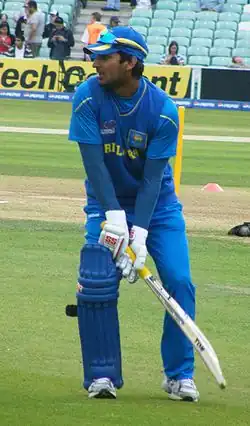
Kumar Sangakkara was the captain of the Deccan Chargers during their last season.
The Hyderabad Deccan Chargers (often abbreviated as DC) was a franchise cricket team based in Hyderabad, Telangana, that competed in the Indian Premier League (IPL) from 2008 to 2012. The team was owned by Deccan Chronicle Holdings Limited who won the bid for the Hyderabad franchise at US$107 million. VVS Laxman and Robin Singh were appointed as the captain and the coach for their first season in 2008. After finishing last in that season, the DC sacked their coach and removed their captain and replaced them with Darren Lehmann and Adam Gilchrist under whom they won their only IPL title in 2009, when they defeated the Royal Challengers Bangalore by six runs in the final. They reached the semi-finals again in 2010 but failed to reach past the group stages before the team was folded in 2012. They qualified for the Champions League Twenty20 only once, for the 2009 season, but failed to advance past the group stage. Lehmann remained as the coach for the DC but they were forced to replace Gilchrist with Kumar Sangakkara in 2011 after they lost former to the Kings XI Punjab in the 2011 auction. Sangakkara remained as the captain until the middle of the 2012 season before he was replaced by Cameron White following the poor performances. Sangakkara later returned as captain as the move did not yield the desired results for the Deccan Chargers.
On 15 September 2012, the Deccan Chargers' IPL contract was terminated by the Board of Control for Cricket in India (BCCI), which was concerned about overdue payments to the players. The Hyderabad franchise was later acquired by the Sun TV Network for ₹85.05 crore (US$10 million) per year in a bid which also retained 20 players. (Full article...) -
 Image 25
Image 25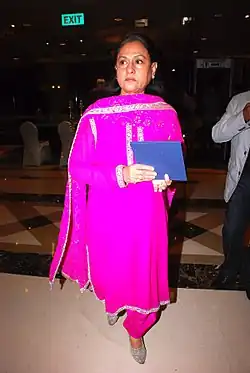
Kal Ho Naa Ho (transl. Tomorrow May Never Come) is a 2003 Indian Hindi-language romantic comedy-drama film directed by Nikkhil Advani. The film stars Jaya Bachchan, Shah Rukh Khan, Saif Ali Khan and Preity Zinta. Sushma Seth, Reema Lagoo, Lillete Dubey and Delnaaz Irani play supporting roles. The film's story focuses on Naina Catherine Kapur (Preity Zinta), an MBA student who falls in love with Aman Mathur (Shah Rukh Khan). He does not reciprocate her feelings as he is a terminally ill heart patient, a fact he hides from Naina. Aman does not wish to bring Naina any pain through his illness, and tries to make her fall in love with her friend and fellow MBA classmate Rohit Patel (Saif Ali Khan). The film's dialogues were written by Niranjan Iyengar while Karan Johar drafted the story and screenplay. The latter also co-produced the film with his father, Yash Johar, under the Dharma Productions banner. The soundtrack for Kal Ho Naa Ho was composed by Shankar–Ehsaan–Loy while Javed Akhtar wrote the lyrics for its songs. Anil Mehta and Sanjay Sankla handled the cinematography and editing respectively. Sharmishta Roy was in charge of the production design.
Produced on a budget of ₹280 million, Kal Ho Naa Ho was released on 27 November 2003 and received positive reviews from critics. It was a commercial success, grossing ₹860.9 million worldwide. The film won 35 awards from 78 nominations; its direction, story, screenplay, performances of the cast members, music and cinematography have received the most attention from award groups. (Full article...)
 Good article –
Good article –
-
 Image 1
Image 1 Aaryan in 2025
Aaryan in 2025
Kartik Aaryan (né Tiwari; born 22 November 1990) is an Indian actor known for his work in Hindi cinema. One of the highest-paid actors in India, he is a recipient of several accolades including one IIFA Award, six Zee Cine Awards, and was featured in Forbes India's Celebrity 100 list of 2019.
While pursuing a degree in engineering, he made his acting debut with Luv Ranjan's buddy film Pyaar Ka Punchnama (2011). He went on to star in the romances Akaash Vani (2013) and Kaanchi (2014), but these failed to propel his career forward. Aaryan had commercial successes in Ranjan's comedies Pyaar Ka Punchnama 2 (2015) and Sonu Ke Titu Ki Sweety (2018), his breakthrough film, as well as the romantic comedies Luka Chuppi and Pati Patni Aur Woh (both 2019). He also played against type in the thrillers Dhamaka (2021) and Freddy (2022), and the romantic drama Satyaprem Ki Katha (2023), and gained praise for portraying Murlikant Petkar in the biopic Chandu Champion (2024). His highest-grossing releases came with the comedy horror films Bhool Bhulaiyaa 2 (2022) and Bhool Bhulaiyaa 3 (2024). The former also earned him a nomination for the Filmfare Award for Best Actor and the latter won him the IIFA Award for Best Actor. (Full article...) -
![Image 2 The Upanishads (/ʊˈpʌnɪʃədz/; Sanskrit: उपनिषद्, IAST: Upaniṣad, pronounced [ˈupɐniʂɐd]) are late Vedic and post-Vedic Sanskrit texts that "document the transition from the archaic ritualism of the Veda into new religious ideas and institutions" and the emergence of the central religious concepts of Hinduism. They are the most recent addition to the Vedas, the oldest scriptures of Hinduism, and deal with meditation, philosophy, consciousness, and ontological knowledge. Earlier parts of the Vedas dealt with mantras, benedictions, rituals, ceremonies, and sacrifices. While among the most important literature in the history of Indian religions and culture, the Upanishads document a wide variety of "rites, incantations, and esoteric knowledge" departing from Vedic ritualism and interpreted in various ways in the later commentarial traditions. The Upanishads are widely known, and their diverse ideas, interpreted in various ways, informed later traditions of Hinduism. The central concern of all Upanishads is to discover the relations between ritual, cosmic realities (including gods), and the human body/person, postulating Ātman and Brahman as the "summit of the hierarchically arranged and interconnected universe", but various ideas about the relation between Atman and Brahman can be found. (Full article...)](./_assets_/Blank.png) Image 2
Image 2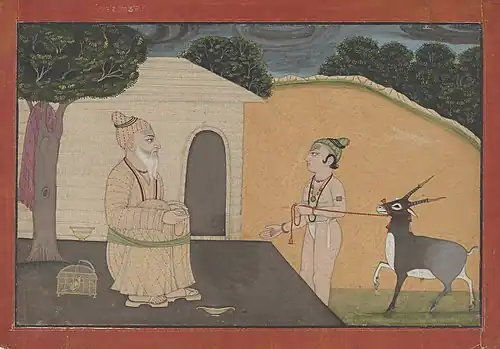
The Upanishads (/ʊˈpʌnɪʃədz/; Sanskrit: उपनिषद्, IAST: Upaniṣad, pronounced [ˈupɐniʂɐd]) are late Vedic and post-Vedic Sanskrit texts that "document the transition from the archaic ritualism of the Veda into new religious ideas and institutions" and the emergence of the central religious concepts of Hinduism. They are the most recent addition to the Vedas, the oldest scriptures of Hinduism, and deal with meditation, philosophy, consciousness, and ontological knowledge. Earlier parts of the Vedas dealt with mantras, benedictions, rituals, ceremonies, and sacrifices.
While among the most important literature in the history of Indian religions and culture, the Upanishads document a wide variety of "rites, incantations, and esoteric knowledge" departing from Vedic ritualism and interpreted in various ways in the later commentarial traditions. The Upanishads are widely known, and their diverse ideas, interpreted in various ways, informed later traditions of Hinduism. The central concern of all Upanishads is to discover the relations between ritual, cosmic realities (including gods), and the human body/person, postulating Ātman and Brahman as the "summit of the hierarchically arranged and interconnected universe", but various ideas about the relation between Atman and Brahman can be found. (Full article...) -
 Image 3
Image 3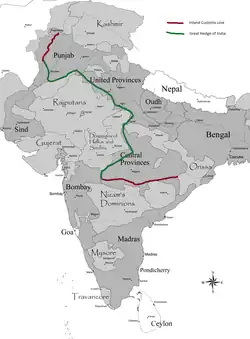
The route of the 1870s Inland Customs Line (red) and Great Hedge (green)
The Inland Customs Line, incorporating the Great Hedge of India (or Indian Salt Hedge), was a customs barrier built by the British colonial rulers of India to prevent smuggling of salt from coastal regions in order to avoid the substantial salt tax.
The customs line was begun under the East India Company and continued into direct British rule. The line had its beginnings in a series of customs houses established in Bengal in 1803 to prevent the smuggling of salt to avoid the tax. These customs houses were eventually formed into a continuous barrier that was brought under the control of the Inland Customs Department in 1843. (Full article...) -
 Image 4
Image 4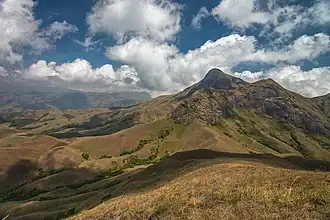 Anamudi, the highest peak in the Western Ghats
Anamudi, the highest peak in the Western Ghats
The Western Ghats, also known as the Sahyadri, is a mountain range that stretches 1,600 km (990 mi) along the western coast of the Indian peninsula. Covering an area of 160,000 km2 (62,000 sq mi), it traverses the Indian states of Gujarat, Maharashtra, Goa, Karnataka, Kerala, and Tamil Nadu. The range forms an almost continuous chain of mountains along the western edge of the Deccan Plateau, from the Tapti River to Swamithoppe in Kanyakumari district at the southern tip of the Indian peninsula. The Western Ghats meet with the Eastern Ghats at Nilgiris before continuing south.
Geologic evidence indicates that the mountains were formed during the break-up of the supercontinent of Gondwana. The mountains arose along the west coast of India somewhere in the late Jurassic and early Cretaceous periods when India separated from the African continent. The mountains can be roughly divided into three parts: the northern section with an elevation ranging from 900–1,500 m (3,000–4,900 ft), the middle section starting south of Goa with a lower elevation of less than 900 m (3,000 ft), and the southern section where the altitude rises again. The Western Ghats have several peaks that rise above 2,000 m (6,600 ft), with Anamudi (2,695 m (8,842 ft)) being the highest peak. The average elevation is around 1,200 m (3,900 ft). (Full article...) -
 Image 5Businessman is a 2012 Indian Telugu-language action crime film directed and written by Puri Jagannadh and produced by R. R. Venkat under the banner R. R. Movie Makers. It is based from a concept by Ram Gopal Varma and stars an ensemble cast featuring Mahesh Babu, Kajal Aggarwal, Prakash Raj, Nassar, Sayaji Shinde, Raza Murad, Subbaraju and Brahmaji. In the film, Vijay Surya arrives at Mumbai with aspirations to rule the city due to his grudge against the corrupt system in the country, but begins to face violent challenges from the cops and his enemies.
Image 5Businessman is a 2012 Indian Telugu-language action crime film directed and written by Puri Jagannadh and produced by R. R. Venkat under the banner R. R. Movie Makers. It is based from a concept by Ram Gopal Varma and stars an ensemble cast featuring Mahesh Babu, Kajal Aggarwal, Prakash Raj, Nassar, Sayaji Shinde, Raza Murad, Subbaraju and Brahmaji. In the film, Vijay Surya arrives at Mumbai with aspirations to rule the city due to his grudge against the corrupt system in the country, but begins to face violent challenges from the cops and his enemies.
S. Thaman composed the music, while Shyam K. Naidu and M. S. Rajashekhar Reddy (S. R. Shekhar) handled the cinematography and editing. The film was made with a budget of ₹40 crore and was launched formally on 15 August 2011 in Hyderabad. Principal photography began on 2 September 2011 and was shot in Hyderabad, Mumbai and Goa. A few song sequences were shot in Bangkok. Filming ended on 10 December 2011 in 74 working days, making as one of the shortest periods in which a Telugu film has been shot. (Full article...) -
![Image 6 Khasi women Multiple tribes in the state of Meghalaya in northeast India practise matrilineal descent. Often referred to as Khasi people and Garo people, among the Khasi people which is a term used as a blanket term for various subgroups in Meghalaya who have distinguishing languages, rites, ceremonies, and habits, but share an ethnic identity as Ki Hynniew Trep (The Seven Huts) whereas the Garo people refers to the various groups of Achik people. The Khasi, Garo, and other subgroups have a proud heritage, including matrilineality, although it was reported in 2004 that they were losing some of their matrilineal traits. The tribes are said to belong to one of the "largest surviving matrilineal culture[s]" in the world. (Full article...)](./_assets_/Blank.png) Image 6
Image 6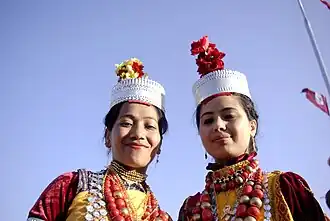
Khasi women
Multiple tribes in the state of Meghalaya in northeast India practise matrilineal descent. Often referred to as Khasi people and Garo people, among the Khasi people which is a term used as a blanket term for various subgroups in Meghalaya who have distinguishing languages, rites, ceremonies, and habits, but share an ethnic identity as Ki Hynniew Trep (The Seven Huts) whereas the Garo people refers to the various groups of Achik people. The Khasi, Garo, and other subgroups have a proud heritage, including matrilineality, although it was reported in 2004 that they were losing some of their matrilineal traits. The tribes are said to belong to one of the "largest surviving matrilineal culture[s]" in the world. (Full article...) -
 Image 7
Image 7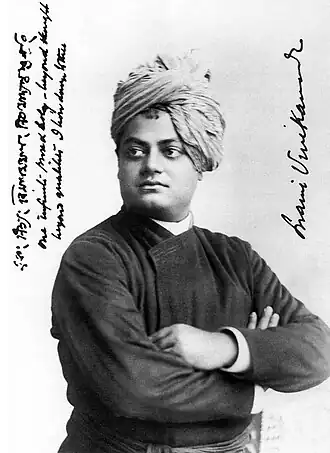 Vivekananda in Chicago, September 1893. In note on the left Vivekananda wrote: "One infinite pure and holy – beyond thought beyond qualities I bow down to thee".
Vivekananda in Chicago, September 1893. In note on the left Vivekananda wrote: "One infinite pure and holy – beyond thought beyond qualities I bow down to thee".
Swami Vivekananda (/ˈswɑːmi ˌvɪveɪˈkɑːnəndə/) (12 January 1863 – 4 July 1902), born Narendranath Datta, was an Indian Hindu monk, philosopher, author, religious teacher, and the chief disciple of the Indian mystic Ramakrishna. Vivekananda was a major figure in the introduction of Vedanta and Yoga to the Western world, and is credited with raising interfaith awareness and elevating Hinduism to the status of a major world religion.
Born into an aristocratic Bengali Kayastha family in Calcutta (now Kolkata), Vivekananda showed an early inclination towards religion and spirituality. At the age of 18, he met Ramakrishna and became his devoted disciple, and later took up the vows of a sannyasin (renunciate). Following Ramakrishna’s death, Vivekananda travelled extensively across the Indian subcontinent as a wandering monk, gaining first-hand knowledge of the often harsh living conditions endured by the Indian masses under then British India, he sought a way to alleviate their suffering by establishing social services but lacked capital. In 1893, he travelled to the United States to participate in the Parliament of the World's Religions in Chicago, where he delivered a landmark speech beginning with the words "Sisters and brothers of America...". His powerful message introduced Hindu spiritual thought and advocated for both religious tolerance and universal acceptance. The speech made a profound impression; an American newspaper described him as "an orator by divine right and undoubtedly the greatest figure at the Parliament". (Full article...) -
 Image 8
Image 8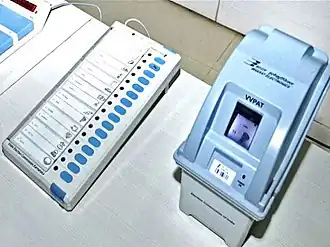
VVPAT used with electronic voting machines in Indian elections
Electronic voting is the standard means of conducting elections using Electronic Voting Machines (EVMs) in India. The system was developed for the Election Commission of India by state-owned Electronics Corporation of India and Bharat Electronics. Starting in the late 1990s, they were introduced in Indian elections in a phased manner.
Prior to the introduction of electronic voting, paper ballots were used and manual counting was done. The printed paper ballots were expensive, required substantial post-voting resources and time to count individual ballots and were prone to fraudulent voting with pre-filled fake ballots. Introduction of EVMs have brought down the costs significantly, reduces the time of counting to enable faster announcement of results and eliminated fraudulent practices due to safety features such as security locking, limits to rate of voting per minute and verification of thumb impressions. EVMs are stand-alone machines that use write once read many memory. They are self-contained, battery-powered and do not need any networking capability. They do not have any wireless or wired components that connect to the internet. (Full article...) -
 Image 9
Image 9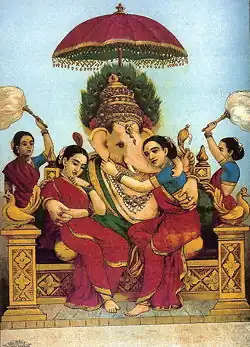
Ganesha with consorts Riddhi (prosperity) and Siddhi (spiritual power), Painting titled "Riddhi Siddhi" by Raja Ravi Varma (1848–1906)
The marital status of the Hindu deity Ganesha varies widely in mythological stories and the issue has been the subject of considerable scholarly review. Several patterns of associations with different consorts are identifiable. One pattern of myths identifies Ganesha as an unmarried brahmacārin with no consorts. Another mainstream pattern associates him with the concepts of Buddhi (intellect), Siddhi (spiritual power), and Riddhi (prosperity); these qualities are sometimes personified as goddesses who are considered to be Ganesha's wives. Another pattern connects Ganesha with the goddess of culture and the arts, Sarasvati. In the Bengal region he is linked with the banana tree, Kala Bo (or Kola Bou). Usually Ganesha's consort is portrayed as his shakti, a personification of his creative energy.
Some of the differences between these patterns can be understood by looking at regional variations across India, the time periods in which the patterns are found, and the traditions in which the beliefs are held. Some differences pertain to the preferred meditation form used by the devotee, with many different traditional forms ranging from Ganesha as a young boy (Sanskrit: बाल गणपति; bālagāņapati) to Ganesha as a Tantric deity. (Full article...) -
 Image 10
Image 10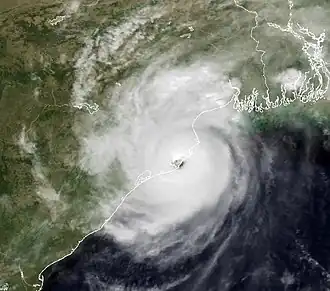 The cyclone on 29 October at its record peak intensity, as it made landfall on Odisha
The cyclone on 29 October at its record peak intensity, as it made landfall on Odisha
The 1999 Odisha cyclone (IMD designation BOB 06, JTWC designation 05B) was the most intense tropical cyclone ever recorded in the North Indian Ocean and among the most destructive in the region. The cyclone organized into a tropical depression in the Andaman Sea on 25 October, though its origins could be traced back to an area of convection in the Sulu Sea four days prior. The disturbance gradually strengthened as it took a west-northwesterly path, reaching cyclonic storm strength the next day. Aided by highly favorable conditions, the storm rapidly intensified, attaining super cyclonic storm intensity on 28 October, before peaking on the next day with winds of 260 km/h (160 mph) and a record-low pressure of 912 mbar (hPa; 26.93 inHg). The storm maintained this intensity as it made landfall on Odisha on 29 October. The cyclone steadily weakened due to persistent land interaction and dry air, remaining quasi-stationary for two days before slowly drifting offshore as a much weaker system; the storm dissipated on 4 November over the Bay of Bengal.
Although its primary effects were felt in a localized area of India, the outer fringes of the super cyclone impacted Myanmar and Bangladesh. Ten people were killed in the former, while two were killed in the latter by the storm's rainbands. The storm was the most severe to strike Odisha in the 20th century, raking the state and adjacent areas with high storm surge, powerful winds, and torrential rainfall. The storm's impacts exacerbated the damage caused by a very severe cyclone that struck the same region less than two weeks earlier. The 5–6 m (16–20 ft) surge brought water up to 35 km (22 mi) inland, carrying along with it coastal debris and inundating towns and villages. The surge combined with heavy rains to produce widespread flooding, damaging around 1.6 million homes and causing rivers to breach 20,005 flood embankments. The storm's effects destroyed numerous crops, including sugar cane, rice, and other winter-time harvests. Although estimates of the death toll varied significantly—at times suggesting 30,000 fatalities—the Government of India enumerated 9,887 fatalities in the country, of which a majority were caused by storm surge; over 8,000 deaths occurred in Jagatsinghpur. The total damage cost of the destruction wrought by the super cyclone amounted to US$4.44 billion. (Full article...) -
 Image 11Maheshinte Prathikaaram (transl. Mahesh's Revenge) is a 2016 Indian Malayalam-language comedy drama film directed by Dileesh Pothan, in his directorial debut and produced by Aashiq Abu. The film stars Fahadh Faasil in the title role alongside a supporting cast including Aparna Balamurali, Anusree, Alencier Ley Lopez and Soubin Shahir. Written by Syam Pushkaran, the story is based on an incident in the life of Thampan Purushan from Thuravoor, Cherthala. Shyju Khalid was the film's cinematographer, and the music was composed by Bijibal.
Image 11Maheshinte Prathikaaram (transl. Mahesh's Revenge) is a 2016 Indian Malayalam-language comedy drama film directed by Dileesh Pothan, in his directorial debut and produced by Aashiq Abu. The film stars Fahadh Faasil in the title role alongside a supporting cast including Aparna Balamurali, Anusree, Alencier Ley Lopez and Soubin Shahir. Written by Syam Pushkaran, the story is based on an incident in the life of Thampan Purushan from Thuravoor, Cherthala. Shyju Khalid was the film's cinematographer, and the music was composed by Bijibal.
Maheshinte Prathikaaram's development began in 2013 when Pothan was working as an associate director for Abu (who was directing Idukki Gold, co-written by Syam). Syam suggested a story idea to Pothan which was based on an incident in his native village. At Pothan's insistence, Syam wrote the screenplay that year and Abu later became interested in producing the film. Production was scheduled to commence from December 2014 after completing the casting process but, due to scheduling conflicts, it was postponed to August 2015. Principal photography began in early August in Idukki and nearby locations, where it was predominantly filmed. Shooting was completed in late October. (Full article...) -
 Image 12
Image 12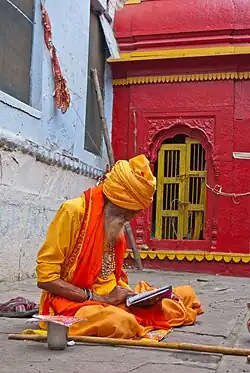 The Bhikshuka Upanishad describes Hindu mendicants who seek spiritual liberation through the practise of yoga
The Bhikshuka Upanishad describes Hindu mendicants who seek spiritual liberation through the practise of yoga
The Bhikshuka Upanishad (Sanskrit: भिक्षुक उपनिषत्, IAST: Bhikṣuka Upaniṣad), also known as Bhikshukopanishad, is one of the minor Upanishads of Hinduism and is written in Sanskrit.
The Upanishad describes four kinds of sannyasins (Hindu monks), their eating habits and lifestyle. Yoga is the path of spiritual liberation for all four. Of these, the Paramahamsa monks are discussed in this text at greater length, and described as loners who are patient with everyone, free from dualism in their thoughts, and who meditate on their soul and the Brahman. (Full article...) -
 Image 13NH10 is a 2015 Indian Hindi-language action thriller film directed by Navdeep Singh and written by Sudip Sharma. It stars Anushka Sharma, Neil Bhoopalam, Darshan Kumar, and Deepti Naval. NH10 was jointly produced by Clean Slate Filmz, Phantom Films, Eros International and marked the production debut of Sharma. It tells the story of a young couple whose road trip goes awry after an encounter with a group of violent criminals. The title refers to the National Highway 10 that connects Delhi to the town of Fazilka in Punjab.
Image 13NH10 is a 2015 Indian Hindi-language action thriller film directed by Navdeep Singh and written by Sudip Sharma. It stars Anushka Sharma, Neil Bhoopalam, Darshan Kumar, and Deepti Naval. NH10 was jointly produced by Clean Slate Filmz, Phantom Films, Eros International and marked the production debut of Sharma. It tells the story of a young couple whose road trip goes awry after an encounter with a group of violent criminals. The title refers to the National Highway 10 that connects Delhi to the town of Fazilka in Punjab.
The film was conceived by Singh and written by Sudip Sharma, who were inspired by some real-life honour killing murder cases. The soundtrack album was composed by Sanjeev-Darshan, Bann Chakraborty, Abhiruchi Chand, Ayush Shrestha, Savera Mehta and Samira Koppikar. Arbind Kannabiran served as the film's cinematographer and Jabeen Merchant was its editor. (Full article...) -
 Image 14No One Killed Jessica is a 2011 Indian Hindi-language crime drama film written and directed by Rajkumar Gupta. It stars Vidya Balan and Rani Mukerji. Based on the Jessica Lal murder case, the film revolves around a bartender who dies after being shot by a politician's son and her sister's struggle to find justice for her death.
Image 14No One Killed Jessica is a 2011 Indian Hindi-language crime drama film written and directed by Rajkumar Gupta. It stars Vidya Balan and Rani Mukerji. Based on the Jessica Lal murder case, the film revolves around a bartender who dies after being shot by a politician's son and her sister's struggle to find justice for her death.
Made on a budget of ₹9 crore (US$1.1 million), No One Killed Jessica was released theatrically on 7 January 2011. The film received widespread critical acclaim for its screenplay and cast performances and emerged as a sleeper hit, grossing ₹45.72 crore (US$5.4 million) approximately in its theatrical run. It was nominated for Best Film, Best Director (Gupta), and Best Actress (Balan) at the 57th Filmfare Awards, where it won Best Supporting Actress (Mukerji). (Full article...) -
 Image 15Aparna Rao (3 February 1950 – 28 June 2005) was a German anthropologist who performed studies on social groups in Afghanistan, France, and some regions of India. Her doctorate studies focused on anthropogeography, ethnology, and Islamic studies. Rao taught anthropology at the University of Cologne, serving for a brief time as chair of the Department of Ethnology at the South Asia Institute of Heidelberg University, Germany.
Image 15Aparna Rao (3 February 1950 – 28 June 2005) was a German anthropologist who performed studies on social groups in Afghanistan, France, and some regions of India. Her doctorate studies focused on anthropogeography, ethnology, and Islamic studies. Rao taught anthropology at the University of Cologne, serving for a brief time as chair of the Department of Ethnology at the South Asia Institute of Heidelberg University, Germany.
Rao's research focused on peripatetic, agrarian populations in Afghanistan, France, Jammu, Kashmir, and western Rajasthan. Rao researched the impact of the conflict in Kashmir on the environment and lives of people. Her 1982 work, Les Ġhorbat d'Afghanistan. Aspects Économiques d'un Groupe Itinérant 'Jat, researched the ethnic makeup and local economy of Afghanistan. Her book Autonomy: Life Cycle, Gender, and Status among Himalayan Pastoralists received the 1999 Choice award. ('Full article...) -
 Image 16
Image 16
The Andaman and Nicobar Islands is a union territory of India comprising 572 islands, of which only 38 are inhabited. The islands are grouped into two main clusters: the northern Andaman Islands and the southern Nicobar Islands, separated by a 150 km (93 mi) wide channel. The capital and largest city of the territory, Port Blair (officially Sri Vijaya Puram), is located approximately 1,190 km (740 mi) from Chennai and 1,255 km (780 mi) from Kolkata in mainland India. The islands are situated between the Bay of Bengal to the west and the Andaman Sea to the east. The northernmost point is 901 km (560 mi) from the mouth of the Hooghly River. Indira Point, located at 6°45'10″N and 93°49'36″E on the southern tip of Great Nicobar, is the southernmost point of India.
The territory shares maritime borders with Indonesia located about 165 km (103 mi) to the south, Myanmar located 280 km (170 mi) to the north-east and Thailand located 650 km (400 mi) to the south-east. The islands occupy a total land area of approximately 8,249 km2 (3,185 sq mi) with a population of 380,581 as per the 2011 census. The territory is divided into three districts: Nicobar, South Andaman, and North and Middle Andaman with the capitals at Car Nicobar, Port Blair and Mayabunder respectively. (Full article...) -
 Image 17
Image 17.jpg) In Jamtra, Madhya Pradesh, India
In Jamtra, Madhya Pradesh, India
The Indian flying fox (Pteropus medius), also known as the greater Indian fruit bat, is a species of flying fox native to the Indian subcontinent. It is one of the largest bats in the world. It is of interest as a disease vector, as it is capable of transmitting several viruses to humans. It is nocturnal and feeds mainly on ripe fruits, such as mangoes and bananas, and nectar. This species is often regarded as vermin due to its destructive tendencies towards fruit farms, but the benefits of its pollination and seed propagation often outweigh the impacts of its fruit consumption. (Full article...) -
 Image 18"Didi Tera Devar Deewana" (transl. Sister, your brother-in-law is crazy) is a 1994 Hindi-language filmi song performed by Lata Mangeshkar and S. P. Balasubrahmanyam for the soundtrack of the 1994 Indian musical romantic drama film Hum Aapke Hain Koun..!. The track was composed by Raamlaxman, while lyrics were written by Dev Kohli. Hum Aapke Hain Koun..! was written and directed by Sooraj R. Barjatya and produced under the banner of Rajshri Productions. The music video of "Didi Tera Devar Deewana" shows the film's ensemble cast and leads Madhuri Dixit and Salman Khan dancing at a baby shower ceremony.
Image 18"Didi Tera Devar Deewana" (transl. Sister, your brother-in-law is crazy) is a 1994 Hindi-language filmi song performed by Lata Mangeshkar and S. P. Balasubrahmanyam for the soundtrack of the 1994 Indian musical romantic drama film Hum Aapke Hain Koun..!. The track was composed by Raamlaxman, while lyrics were written by Dev Kohli. Hum Aapke Hain Koun..! was written and directed by Sooraj R. Barjatya and produced under the banner of Rajshri Productions. The music video of "Didi Tera Devar Deewana" shows the film's ensemble cast and leads Madhuri Dixit and Salman Khan dancing at a baby shower ceremony.
The song became very famous after its release, with it reaching various music charts and bagging the Filmfare Special Award for Mangeshkar. The purple jaded satin saree designed by Anna Singh and sported by Dixit in the video trended in the markets, being also merchandised. Dixit's dance and looks throughout the clip were met with highly positive reviews. After watching the song's video, artist M. F. Husain found his muse in Dixit and went on to paint a series of paintings on her. The song is also featured on the dance rhythm video game Just Dance 3 with the song credited as Kurio ko uddah le jana by Bollywood Rainbow. (Full article...) -
![Image 19 Ashwin in 2015 Ravichandran Ashwin (Tamil: [ɾaʋitɕand̪iɾan aɕʋin]; pronunciation) (born 17 September 1986) is an Indian cricketer. He is a right-arm off spin bowler and a lower order batter. Widely regarded as one of the most prolific spinners of all time, he represented the Indian cricket team and was part of the Indian team that won the 2011 Cricket World Cup and the 2013 Champions Trophy. He plays for Tamil Nadu and South Zone in domestic cricket and for Chennai Super Kings in the Indian Premier League (IPL). Ashwin has taken more than 500 wickets in Tests and was the fastest bowler to reach 300 test wickets in terms of number of innings. He has won eleven Man of the Series awards in Tests, which is the most for any cricketer, along with Muttiah Muralitharan. As an all-rounder in Test cricket, he bats down the order, has scored six Test centuries and is one of the only three players to have scored 3000 runs and taken 500 wickets in Tests. He had been the highest-ranked bowler in the ICC men's player rankings multiple times, and holds the record for the second highest rating points by an Indian bowler ever in Test cricket. (Full article...)](./_assets_/Blank.png) Image 19
Image 19%252C_Shri_Sarbananda_Sonowal_conferring_the_Arjuna_Award_on_cricketer_Ravichandran_Ashwin%252C_in_New_Delhi_on_July_31%252C_2015_cropped.jpg) Ashwin in 2015
Ashwin in 2015
Ravichandran Ashwin (Tamil: [ɾaʋitɕand̪iɾan aɕʋin]; pronunciation) (born 17 September 1986) is an Indian cricketer. He is a right-arm off spin bowler and a lower order batter. Widely regarded as one of the most prolific spinners of all time, he represented the Indian cricket team and was part of the Indian team that won the 2011 Cricket World Cup and the 2013 Champions Trophy. He plays for Tamil Nadu and South Zone in domestic cricket and for Chennai Super Kings in the Indian Premier League (IPL).
Ashwin has taken more than 500 wickets in Tests and was the fastest bowler to reach 300 test wickets in terms of number of innings. He has won eleven Man of the Series awards in Tests, which is the most for any cricketer, along with Muttiah Muralitharan. As an all-rounder in Test cricket, he bats down the order, has scored six Test centuries and is one of the only three players to have scored 3000 runs and taken 500 wickets in Tests. He had been the highest-ranked bowler in the ICC men's player rankings multiple times, and holds the record for the second highest rating points by an Indian bowler ever in Test cricket. (Full article...) -
 Image 20
Image 20 Sculpture of Kulottunga I at Nataraja Temple.
Sculpture of Kulottunga I at Nataraja Temple.
Kulottunga Chola I (/kʊˈloʊtʊŋɡə/; Middle Tamil: Kulōttuṅka Cōḻaṉ; Classical Sanskrit: Kulottuṅgā Cōḷa; 1025–1122) also spelt Kulothunga (lit. 'The Exalter of His Clan'), born Rajendra Chalukya (Telugu: Rājēndra Cāḷukyuḍu), was a Chola Emperor who reigned from 1070 to 1122 succeeding his cousin Athirajendra Chola. He also served as the Eastern Chalukya monarch from 1061 to 1118, succeeding his father Rajaraja Narendra. He is related to the Chola dynasty through his mother's side and the Eastern Chalukyas through his father's side. His mother, Ammangaidevi, was a Chola princess and the daughter of emperor Rajendra Chola I. His father was king Rajaraja Narendra of the Eastern Chalukya dynasty who was the nephew of Rajendra and maternal grandson of Rajaraja Chola I. According to historian Sailendra Nath Sen, his accession marked the beginning of a new era and ushered in a period of internal peace and benevolent administration. He was succeeded by his son Vikrama Chola.
Kulottunga had diplomatic relations with the northern Indian city Kannauj and also with distant countries like Cambodia, Srivijaya, Khmer, Pagan (Burma) and China. He established Chola overlordship over the Srivijayan province of Kedah in Malay Peninsula. An inscription in a Taoist temple in Guangzhou, dated to 1079, declares Kulottunga, king of Chulien (Chola) to be the supreme chief of the Land of San-fo-tsi (Srivijaya). According to Tan Yeok Seong, the editor of the inscription, Kulottunga ruled both the Chola and Srivijayan kingdoms. In the small Leyden grant that is dated to 1090, the king of Kadaram (Srivijaya) is mentioned as a vassal of Kulottunga. Like his predecessors, Kulottunga was a patron of arts and literature and the much celebrated Tamil poem Kalingattuparani was composed during his rule by poet Jayamkondaan who lived in his court. His records also testify to the highly organised system of fiscal and local administration. During his reign Kulottunga carried out a massive land survey that formed the basis for taxation. (Full article...) -
 Image 21
Image 21
Balanathan Benjamin Mahendran (20 May 1939 – 13 February 2014), commonly known as Balu Mahendra, was a Sri Lankan Tamil cinematographer, director, screenwriter and film editor who worked in various Indian film industries, primarily in Tamil and Malayalam cinema. Born in Sri Lanka, Mahendran developed a passion for photography and literature at a young age, after witnessing the shoot of David Lean's The Bridge on the River Kwai (1957) during a school trip in Sri Lanka, he was drawn towards filmmaking. After graduation he joined as an Aerial photographer in the Sri Lankan Government. In 1966, he moved to India and gained admission to the Film and Television Institute of India (FTII) to pursue a course in motion picture photography. Upon completion of his diploma, he entered Malayalam cinema as a cinematographer in the early 1970s.
After working in over 20 films as a cinematographer, Mahendra made his directorial debut in 1977 with the Kannada film Kokila. Since then, he directed over 20 films in a span of 36 years. Along with Bharathiraja and Mahendran, he is regarded as a trendsetter in Tamil cinema. Widely regarded as an auteur, Mahendra usually scripted and edited his films apart from shooting them. He was the recipient of six National Film Awards (including two for Best Cinematography), five Filmfare Awards South and several state government awards. During the tail end of his career, he established a film school in Chennai, which offers courses in cinematography, direction and acting. Following a brief phase of poor health, Mahendra died of cardiac arrest in February 2014. (Full article...) -
 Image 22
Image 22 The PSLV-CA launch vehicle rolled out at Sriharikota First, prior to flight C42
The PSLV-CA launch vehicle rolled out at Sriharikota First, prior to flight C42
PSLV-C42 was the 44th mission of the Indian Polar Satellite Launch Vehicle (PSLV) program and its 12th mission in the Core Alone (CA) configuration. PSLV-C42 successfully carried and deployed 2 Earth observation satellites in Sun-synchronous orbits at an altitude of 588 kilometres (365 mi). It was launched on 16 September 2018 by the Indian Space Research Organisation (ISRO) from the first launch pad of the Satish Dhawan Space Centre at Sriharikota, Andhra Pradesh. The two international satellites were launched as part of a commercial arrangement between Surrey Satellite Technology Limited (SSTL) and ISRO's commercial arm Antrix Corporation Limited, run under the auspices of the Indian Government's Department of Space. (Full article...) -
 Image 23Vikram Vedha is a 2017 Indian Tamil-language neo-noir action thriller film written and directed by Pushkar–Gayathri and produced by YNOT Studios. The film, which is inspired by the Indian folktale Baital Pachisi, stars R. Madhavan and Vijay Sethupathi as the title characters, alongside Shraddha Srinath, Kathir, Varalaxmi Sarathkumar, Prem, Achyuth Kumar, Hareesh Peradi and Vivek Prasanna. In the film, Inspector Vikram sets out to track down and kill Vedha, a gangster. After voluntarily surrendering himself, Vedha tells Vikram three stories which change his perceptions of good and evil.
Image 23Vikram Vedha is a 2017 Indian Tamil-language neo-noir action thriller film written and directed by Pushkar–Gayathri and produced by YNOT Studios. The film, which is inspired by the Indian folktale Baital Pachisi, stars R. Madhavan and Vijay Sethupathi as the title characters, alongside Shraddha Srinath, Kathir, Varalaxmi Sarathkumar, Prem, Achyuth Kumar, Hareesh Peradi and Vivek Prasanna. In the film, Inspector Vikram sets out to track down and kill Vedha, a gangster. After voluntarily surrendering himself, Vedha tells Vikram three stories which change his perceptions of good and evil.
In January 2015, Sashikanth revealed that he would be producing a film directed by Pushkar–Gayathri. Following a year of development on the script throughout 2015, Madhavan and Sethupathi were selected to play the lead roles in February 2016. Principal photography began in November of the same year and was completed by January 2017. The film was shot mainly in North Chennai, with the area being used as its backdrop. Sam C. S. composed the soundtrack and score, while P. S. Vinod and A. Richard Kevin handled the cinematography and editing respectively. (Full article...) -
 Image 24
Image 24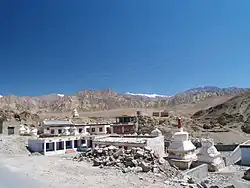 Alchi Monastery
Alchi Monastery
Alchi Monastery (Tibetan: ཨ་ལྕི་ཆོས་འཁོར།) or Alchi Gompa (Tibetan: ཨ་ལྕི་དགོམ་པ།, also Alci) is a Tibetan Buddhist monastery, known more as a monastic complex (chos-'khor) of temples in Alchi village in the Leh District, under the Ladakh Autonomous Hill Development Council of the Union Territory of Ladakh, India. The complex comprises four separate settlements in the Alchi village in the lower Ladakh region with monuments dated to different periods. Of these four hamlets, Alchi monastery is said to be the oldest and most famous. It is administered by the Likir Monastery. It is 60 west of Leh on Leh-Kargil Highway.
Alchi is also part of the three villages (all in lower Ladakh region) which constitute the ‘Alchi group of monuments’; the other two villages adjoining Alchi are the Mangyu and Sumda Chun. The monuments in these three villages are stated to be of "unique style and workmanship’, but the Alchi monastic complex is the best known. (Full article...) -
 Image 25Padayappa is a 1999 Indian Tamil-language action drama film written and directed by K. S. Ravikumar. It stars Sivaji Ganesan in his penultimate release and Rajinikanth in the titular lead. Ramya Krishnan and Soundarya share other lead roles, while Lakshmi, Radha Ravi, Nassar, Abbas, Sithara and Preetha play supporting roles. The soundtrack album and background score were composed by A. R. Rahman. The film revolves around the title character and his family being targeted in a generations-long revenge by his cousin Neelambari, a narcissistic woman who was left humiliated after Padayappa rejected her love proposal as he was in love with her good-natured home worker Vasundhara.
Image 25Padayappa is a 1999 Indian Tamil-language action drama film written and directed by K. S. Ravikumar. It stars Sivaji Ganesan in his penultimate release and Rajinikanth in the titular lead. Ramya Krishnan and Soundarya share other lead roles, while Lakshmi, Radha Ravi, Nassar, Abbas, Sithara and Preetha play supporting roles. The soundtrack album and background score were composed by A. R. Rahman. The film revolves around the title character and his family being targeted in a generations-long revenge by his cousin Neelambari, a narcissistic woman who was left humiliated after Padayappa rejected her love proposal as he was in love with her good-natured home worker Vasundhara.
Principal photography for the film began in October 1998. Padayappa was released on 10 April 1999 on the eve of Tamil New Year's Day. This was the first Tamil film to be released worldwide with 210 prints and 700,000 audio cassettes. It became Tamil cinema's highest-grossing film at that point. Ramya Krishnan's performance was praised, winning her a Filmfare Award under the Best Actress category. The film also won five Tamil Nadu State Film Awards. (Full article...)
News
- 20 August 2025 – China–India relations
- India and China agree to resume direct flights suspended since 2020, reopen designated border trade points and boost investment in their economies following talks in New Delhi between Chinese foreign minister Wang Yi and Indian officials, including Indian prime minister Narendra Modi. (Reuters)
- 17 August 2025 –
- At least seven people are killed and five others are injured when a cloudburst causes flash flooding and landslides in Kathua district, Jammu and Kashmir, India. (Hindustan Times) (Daily Excelsior)
- 15 August 2025 –
- A bus collides with a stationary truck in Bardhaman, West Bengal, India, killing ten people and injuring 35 others. (Hindustan Times)
- 14 August 2025 – 2025 Kishtwar district flash flood
- At least 65 people are killed, while more than 167 others are injured, including 38 critically, and over 220 are reported missing following a massive cloudburst in Kishtwar, Jammu and Kashmir, India. (India TV) (Hindustan Times)
- 12 August 2025 –
- Indian police arrest dozens of animal rights activists protesting at the India Gate in New Delhi against the Supreme Court's decision to remove over 5,000 stray dogs from the streets as New Delhi sees nearly 2,000 dog bites per day. (DW)
Did you know...
- ... that after becoming a religious leader of the Upper Skagit Indian Tribe, Slaybebtikud united the tribes and established himself as their sole leader?
- ... that a 17th-century painting depicts an Indian emperor shooting arrows at a personification of poverty?
- ... that Indian historian R. Champakalakshmi was a script consultant for Bharat Ek Khoj, a television series based on Jawaharlal Nehru's The Discovery of India?
- ... that independent India's first female pilot, Usha Sundaram, holds the record for the fastest flight between England and India in a piston-engine aircraft?
- ... that there is a dispute within the Indian communist movement on whether the Communist Party of India was founded in Tashkent in 1920 or Kanpur in 1925?
- ... that the joint-most successful team in the Indian Premier League finished last in 2025?
Topics related to India
Timeline of Indian history, Indus Valley Civilisation, Dholavira, Science and technology in ancient India, Meluhha, Aryan invasion theory, Out of India theory, Greek conquests in India, Indian maritime history, Maurya Empire, Ashoka, Shunga Empire, Hoysala Empire, Vijayanagara, Satavahana dynasty, Indo-Greek Kingdom, Indo-Scythians, Indo-Parthian Kingdom, Kushan Empire, Western Satraps, Gupta Empire, Chola dynasty, Pala Empire, Islamic incursions in India, Mughal Empire, Maratha Empire, British Raj, East India Company, Governor-General, Viceroy, War of Independence, 1857, Indian independence movement, Indian National Army, Azad Hind, Quit India Movement, Partition of India, History of Republic of India, Non-Aligned Movement, Sino-Indian War, Indo-Pakistani War of 1947–1948, Indo-Pakistani War of 1965, Indo-Pakistani War of 1971, Kargil War, 2001–02 India–Pakistan standoff, Military, Demographic
Law, Hindu law, Constitution, Political parties (Indian National Congress, Bharatiya Janata Party), Foreign relations, Elections, Political divisions, Reservation in India
Government agencies, Legislative branch (Lok Sabha, Rajya Sabha) Executive branch (President & Vice President, Prime Minister & Deputy Prime Minister, Cabinet Ministers, Cabinet Secretary, Election Commission, Foreign Minister; Law enforcement: CBI, CID, Intelligence: IB, RAW), Directorate General of Income Tax Investigation Judicial branch (Supreme Court), Armed Forces (Army, Navy, Air Force, Border Security Force, Coast Guard)
Himalayas, Western Ghats, Eastern Ghats, Indo-Gangetic Plain, Deccan Plateau, Thar Desert, Ganges, Rann of Kutch, Brahmaputra River, Northeast India; Mountains, Valleys, Islands, Rivers; States and union territories, Cities, Districts, Regions, Fauna, Flora
Rupee, Bombay Stock Exchange, National Stock Exchange, Standard of living, Companies, Reserve Bank of India, Energy policy (Solar, Wind, Nuclear), Tourism, Transport (Expressways, Rail transport, Auto rickshaw),
Languages, Standard of living, Religion
Music (Carnatic, Hindustani, Indi-pop), Dance, Languages, Literature, Architecture, Film & TV, Cuisine, Holidays, Folklore, Education, Media, Indian martial arts
Indian Council of Agricultural Research (ICAR), Indian Institute of Astrophysics, National Centre for Software Technology, AIIMS, IISc, IIT, NIT, BITS-Pilani, INRegistry, Indian numbering system, Indian Space Research Organisation, National Internet Exchange of India, ICRISAT, International Institute of Information Technology, Hyderabad
Indian English, Indian nationality law, Numbering system, Indian Space Research Organisation, Telecommunications, National Highways Development Project, Flag, Vehicle registration plates, Indian nationalism, Metrication in India
Categories

Related portals
Religions in India
Indian Subcontinent
Other countries
Wikipedias in Indian languages
- অসমীয়া (Assamese)
- বাংলা (Bengali)
- भोजपुरी (Bhojpuri)
- বিষ্ণুপ্রিয়া মণিপুরী (Bishnupriya Manipuri)
- गोंयची कोंकणी / Gõychi Konknni (Konkani)
- ગુજરાતી (Gujarati)
- हिन्दी (Hindi)
- ಕನ್ನಡ (Kannada)
- कॉशुर/كشميري (Kashmiri)
- मैथिली (Maithili)
- മലയാളം (Malayalam)
- मराठी (Marathi)
- नेपाली (Nepali)
- नेपाल भाषा
- (Newari)
- ଓଡ଼ିଆ (Odiya)
- ਪੰਜਾਬੀ (Punjabi)
- पालि (Pali)
- संस्कृत (Sanskrit)
- ᱥᱟᱱᱛᱟᱲᱤ (Santali)
- سنڌي (Sindhi)
- தமிழ் (Tamil)
- తెలుగు (Telugu)
- ತುಳು (Tulu)
- اردو (Urdu)
Associated Wikimedia
The following Wikimedia Foundation sister projects provide more on this subject:
-
Commons
Free media repository -
Wikibooks
Free textbooks and manuals -
Wikidata
Free knowledge base -
Wikinews
Free-content news -
Wikiquote
Collection of quotations -
Wikisource
Free-content library -
Wikiversity
Free learning tools -
Wikivoyage
Free travel guide -
Wiktionary
Dictionary and thesaurus
-
 List of all portals
List of all portals -

-

-

-

-

-

-

-

-

-
 Random portal
Random portal -
 WikiProject Portals
WikiProject Portals
